Charlotte Fenwick
Our ferries have in their working lives, since they are working every single day, the capacity to detail just how hard Australians have strived to make a nation and also, in their tasks and duties and being out in all weathers, chronicle much of our own history as interwoven with theirs. In the decades where we were purely a maritime country due to a lack of navigable roads, our rivers, lakes and coastlines were crowded with small, large and middle sized vessels.
The Charlotte Fenwick, still spoken of in Pittwater with affection by those who have heard of her deeds, bridges our shifts in vessel development as she had the best of the old and showed a little of what we have today. Her working life, seemingly fishing at night and carrying passengers during the day amongst numerous other duties, her numerous mishaps and overhauling, beginning as a 50 ton vessel and growing larger then smaller again, demonstrate how a good steamer was adapted and adaptable. As always we list as much as possible of all she did to honour her and the material. Our aim is to allow you to glimmer how hard she worked and how many waters she visited, and also, hopefully, see her out the corner of your eye again. She began here, left here, and returned here again; how many miles did she travel between these years.... how many people's lives did she touch....
The Charlotte Fenwick was a screw steamer built in Sydney for John Fenwick and named after his wife. Built by Walter Macfarlane Ford Snr., legendary boat builder of Berry’s Bay Walter Macfarlane Ford:
. . . The steamer Charlotte Fenwick, which was launched from Mr. Dunn’s yard, at Berry’s Bay, in September last, is now completed, and may be expected to commence work shortly. She is a finely modelled vessel of the following dimensions:- Length, 90 feet ; beam, 18 feet ; depth of hold, 7 feet 6 inches, which give her a net register of 50 tons. The Charlotte Fenwick is a screw steamer. Her engines, which are on the compound surface condensing principle, were made by Messrs. Plenty and Sons, of Newbury, and are of 21 horse power nominal, the cylinders being of 12 inches and 22 inches, and the length of stroke 15 inches. The Charlotte Fenwick is the property of Mr. John Fenwick, of Sydney . . . ” Excerpt – ‘Sydney Morning Herald’ – published 12th July 1884
Mr. Walter Macfarlane Ford, of North Sydney, died suddenly at a private hospital, following an operation for appendicitis, He was 64 years of age. Mr. Ford was a well-known shipbuilder. The business was established in Berry's Bay in 1871 by his father, who died a few weeks ago. Mr. W. M. Ford carried it on himself for about 40 years, and built many vessels well known on Sydney Harbour, including the late Sir Thomas Dibbs's yacht Ena, Sir Samuel Hordern's White Wings, and three yachts for the late Mr. E. F. Simpson. Many Island schooners and trading vessels also came from his yard, and also the ferry boat, the Kulgoa. He was at one time a popular sailing skipper, his 18-footer, Australian, being a successful competitor in harbour events.
For several years, Mr. Ford was a churchwarden of Christ Church, Lavender Bay. He also took a keen Interest in local civic affairs. Recently, he presented a drinking fountain to the North Sydney Council for erection in Ball's Head reserve.
Mr. Ford is survived by one sister and three brothers. The funeral will take place on Sunday afternoon, leaving his late residence, Fairview, Victoria-street, North Sydney, at 3.30, for Gore Hill Cemetery. MR. W. M. FORD. (1934, December 8). The Sydney Morning Herald (NSW : 1842 - 1954), p. 22. Retrieved from http://nla.gov.au/nla.news-article28019840
A screw steamer is a steamship or steamboat, powered by a steam engine, using one or more propellors, also known as screws, to propel it through the water. This term is usually used in to distinguish between these vessels and paddle steamers, an earlier form of steamship that was largely, but not entirely, superseded by the screw steamers.
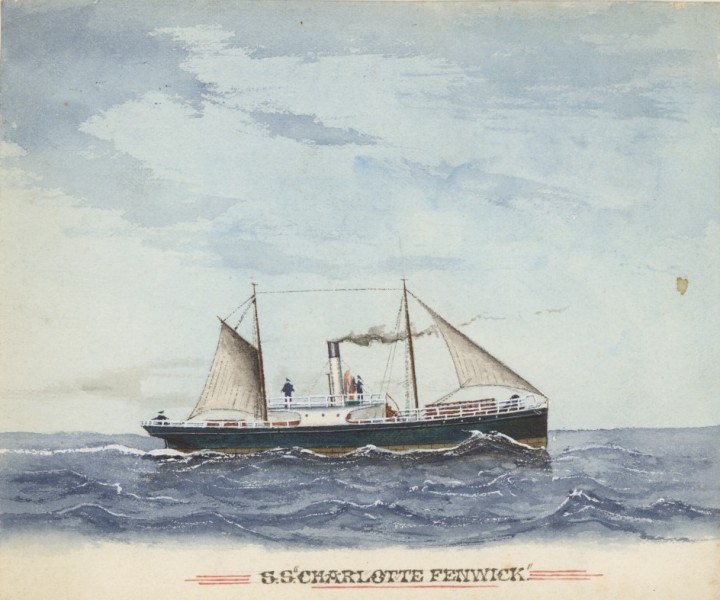
S.S. "Charlotte Fenwick" [art original]. Steamship with central funnel, for and aft masts with sails. Creator Allan C. Green, Allan C., 1878-1954, (artist.) Image 2738 224 courtesy State Library of Victoria, circa 1895 - showing colours and length/changed vessel when in Victoria.
The Charlotte Fenwick was launched in September 1883 and her dimensions and weight at this stage were;
The steamer Charlotte Fenwick, which was launched from Mr. Dunn's yard, at Berry's Bay, in September last, is now completed, and may be expected to commence work shortly. She is a finely-modelled vessel of the following dimensions :-Length, 90 feet; beam, 18 feet ; depth of hold, 7 feet 6 inches, which give her a net register of 50 tons. The Charlotte Fenwick is a screw steamer. Her engines, which are on the compound surface condensing principle, were made by Messrs. Plenty and Sons, of Newbury, and are of 21 horse power nominal, the cylinders being of 12 inches and 22 inches and the length of stroke 15 inches. The Charlotte Fenwick is the property of Mr. John Fenwick, of Sydney. EXPORTS.—JULY 11. (1884, July 12). The Sydney Morning Herald (NSW : 1842 - 1954), p. 10. Retrieved from http://nla.gov.au/nla.news-article28369599
John Fenwick was from a ship building and ship owning family;
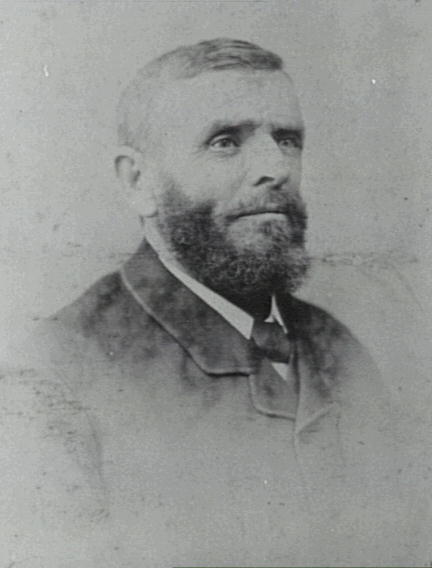 Death of Mr. John Fenwick. THE 'S. M. Herald ' says:--The news of the death of Mr. John Fenwick, at his residence, Belmore, early on Tuesday morning, was received with expressions of deep regret in city shipping circles. For several years Mr. Fenwick had retired from active business life, and though he was daily to be found at his Bridge-street offices, the business of Messrs. John Fenwick and Sons was left in the hands of the latter, Mr. James and Mr. Andrew Fenwick. The late shipowner was a colonist of nearly 52 years standing, having arrived here from Scotland in 1849.
Death of Mr. John Fenwick. THE 'S. M. Herald ' says:--The news of the death of Mr. John Fenwick, at his residence, Belmore, early on Tuesday morning, was received with expressions of deep regret in city shipping circles. For several years Mr. Fenwick had retired from active business life, and though he was daily to be found at his Bridge-street offices, the business of Messrs. John Fenwick and Sons was left in the hands of the latter, Mr. James and Mr. Andrew Fenwick. The late shipowner was a colonist of nearly 52 years standing, having arrived here from Scotland in 1849.
Like his father, he took up the shipping and ship-building business, and with his brother, the late Mr. Thomas Fenwick, of the Richmond River, devoted his energies chiefly to the construction and proprietorship of tugboats and boats for supplying the shipping with fresh water. He was probably the first tugboat owner in Port Jackson with the screw steamer J. and T. Fenwick in 1870.
Before that date the shifting of ships from wharf to stream and vice versa was accomplished by means of their own canvas. Under the style of J. and T. Fenwick a flourishing business was established and conducted for many years. Then the brothers separated, one taking up the Northern River business, and the late Mr. John Fenwick remaining here. Since the days of the tug J. and T. Fenwick the late shipowner has either solely, or in conjunction with others, owned 18 tugboats of various sizes, inclusive of the imported steamers Hero, Newburgh, and Leveret. Amongst the last of the harbour steamers he built was the Dayspring, a vessel which he subsequently sold to the Government.
Mr. Fenwick was a native of Newburgh, Fyfeshire, and was born on May 15, 1836. He was twice married, and leaves a family of eight, three by his first wife, and five by his second wife, now a widow. For a longtime he suffered from chronic bronchitis, upon which pneumonia supervened, ending in his death. Death of Mr. John Fenwick. (1901, February 2). Northern Star(Lismore, NSW : 1876 - 1954), p. 10. Retrieved from http://nla.gov.au/nla.news-article72075745
The Charlotte Fenwick was sent to Brisbane on September 4th 1884
Charlotte Fenwick (s.), 50 tons, Captain W. Brown, for Brisbane, in ballast. Passengers—Messrs. H. B. Woodward, John Fenwick, J. Fenwick, and E. Murray. CLEARANCES.—SEPTEMBER 3. (1884, September 4). The Sydney Morning Herald (NSW : 1842 - 1954), p. 8. Retrieved from http://nla.gov.au/nla.news-article13560441
There she plied her trade mainly as a river steamer and excusions vessel, not without the usual incidents that occur in a nation whose early means of getting around was to use waterways that then became crowded with all those on them;
The steamer Warrego grounded in the river this morning while trying to avoid a collision with the small steamer Charlotte Fenwick. The latter struck the Warrego almost broadside on, damaging her own bulwarks, but the Warrego was uninjured, she, however, remains aground, but is expected to get off at high water. QUEENSLAND. (1884, December 19). The Sydney Morning Herald (NSW : 1842 - 1954), p. 8. Retrieved from http://nla.gov.au/nla.news-article13577700
The Wanego only escaped a collision with the Charlotte Fenwick in coming up the river yesterday by running aground. Our Brisbane Letter. (1885, January 1). Cairns Post (Qld. : 1884 - 1893), p. 3. Retrieved from http://nla.gov.au/nla.news-article39425797
By 1885 she was back in Sydney and placed on the route to Brisbane Waters and surrounds;
Charlotte Fenwick, s. arrived in Sydney on Thursday from Brisbane. SHIPPING. (1885, June 13). The Brisbane Courier (Qld. : 1864 - 1933), p. 4. Retrieved from http://nla.gov.au/nla.news-article3442955
The screw steamer Charlotte Fenwick has been sold by Mr. John Fenwick to Mr. Lyall Scott, of Sydney. EXPORTS.—SEPTEMBER 22. (1885, September 23). The Sydney Morning Herald (NSW : 1842 - 1954), p. 8. Retrieved from http://nla.gov.au/nla.news-article13598818
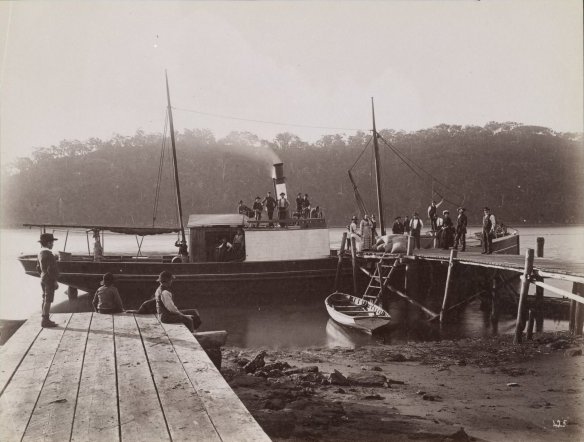 Left: Peats Ferry wharf, Hawkesbury River, New South Wales, ca. 1885, photo by Charles Bayliss, nla.pic-vn4278003 courtesy National Library of Australia.
Left: Peats Ferry wharf, Hawkesbury River, New South Wales, ca. 1885, photo by Charles Bayliss, nla.pic-vn4278003 courtesy National Library of Australia.
GOSFORD, BRISBANE Water. S.S. CHARLOTTE" FENWICK. SPECIAL NOTICE. On and after MONDAY, the 10th November, the s.s. CharlotteFenwick will leave Patent Slip Wharf at 8.0 a.m.., and No. 2Jetty; Circular Quay, at NINE a.m. daily, leaving Gosford on the return trip at TWO p.m. LYALL SCOTT, Patent Slip Wharf. GOSFORD, BRISBANE WATER. The undersigned begs to notify that the S.S. PROMISE is not running in any way in connection with the CHARLOTTE FENWICK, and that Mr. M'Donald and J. Nicholson (late of the Promise), are now interested in the Charlotte Fenwick. It is unnecessary to say anything as to which is the fastest and most comfortable boat, as facts are more to be relied upon than advertisements, and the comfort, speed, and regularity of the trips made by the Charlotte Fenwick speak for themselves. She was put into trade to meet the requirements of the increasing traffic which the Promise was found inadequate. Advertising. (1885, November 16). The Sydney Morning Herald (NSW : 1842 - 1954), p. 1. Retrieved from http://nla.gov.au/nla.news-article13603700
The steamer CHARLOTTE FENWICK leaves PATENT SLIP WHARF at 8.30 a.m., and No.2 JETTY, Circular Quay, at 9 a.m. daily, leaving GOSFORD, on the Return Trip, at 2 p.m., giving passengers about two hours in Gosford, and landing them in Sydney about 5 p.m.- Special Trips OnSundays at Excursion Rates. Leaving the PatentSlI "Wharf at8.80 a.m., calling at Darling street, Balmain, and No. 2 Jetty, Circular Quay, at a.m. The supenior accommodation and sea going qualities of this steamer, as well as the speed and regularity of her trips, offer special inducements to pasengersg , LYALL SCOTT.Patent Slip Wharf. Advertising. (1886, January 25). Globe (Sydney, NSW : 1885 - 1887), p. 1 Edition: EVENING. Retrieved from http://nla.gov.au/nla.news-article102555017
GOSFORD, BRISBANE WATER. ss. CHARLOTTE FENWICK. S.S. PRINCESS. With a view to meet the increasing traffic and in compliance with the request of a large number of residents of the district, the fast and favourite steamer IOLANTHE (pictured) has been chartered to run in conjunction with the CHARLOTTE FENWICK, pending the completion of the new steamer for the owners of the latter vessel. 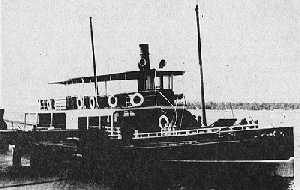 The CHARLOTTE FENWICK will leave the Patent Slip Wharf daily at 8.30 am. s; and No. 2 Jetty at Circular Quay at 9 a.m.., returning from Gosford at 2 p.m, thus giving Passengers two hours in Gosford, and landing them in Sydney about 5 p.m. Special trips at excursion rates on Sundays leaving the Patent Slip Wharf at 8.30a.m. Balmain Darling Street Wharf at 8.40 a.m. and No. 2 Jetty Circular Quay, at 9 am.; leaving Gosford on tlhe return trip at 2 p.m.
The CHARLOTTE FENWICK will leave the Patent Slip Wharf daily at 8.30 am. s; and No. 2 Jetty at Circular Quay at 9 a.m.., returning from Gosford at 2 p.m, thus giving Passengers two hours in Gosford, and landing them in Sydney about 5 p.m. Special trips at excursion rates on Sundays leaving the Patent Slip Wharf at 8.30a.m. Balmain Darling Street Wharf at 8.40 a.m. and No. 2 Jetty Circular Quay, at 9 am.; leaving Gosford on tlhe return trip at 2 p.m.
The IOLANTHE will leave Patent Slip Wharf daily (Sunday excepted)n at 1.30 p.m.; andd No. 2 Jetty, Circular Quay, at 2 p.m.; leaving Gosord on her return trip at 8.30 p.m. Return tickets available by either steamer. Fares and freight as usual. Intending Passengers can rely on speedy. comfortable and regular trips, and that every attention will he paid to their requirements on board. Shippers of goods can depend on every care being taken of their consignments by the Wharfinger at the Sydney end, and by Messrs. Barry and Son, the Gosford gents. LYALL SCOTT, Patent Slip Wharf. Advertising. (1886, February 18). Globe (Sydney, NSW : 1885 - 1887), p. 1 Edition: EVENING. Retrieved from http://nla.gov.au/nla.news-article102563515
Lyall Scott was appointed a Justice of the Peace in 1861, taking his place on the Brisbane Water Bench of Magistrates for the hearing of many cases. Scott had an inclination toward expedient, practical judgments. He was an MP for NSW Parliament at the time of above adevrtisements, the member for Wollombi, and clearly a man who looked after his constituents. Born in Balwyllo, Scotland he arrived in New South Wales c.1852. In 1858 and again in 1866 was described as a timber merchant at Brisbane Water. The son of Robert Scott and Susana Lyall, farmers he married Mary Louisa Pashley on 17 December 1858 at Sydney and had no issue and then married Martha Matilda Pashley on 10 March 1866 at Sydney with whom he had two daughters and a son. He was a Church of England man. Interestingly on June 18th 1886 he was one of the MP’s who held a position on the ‘Alleged Abuses in Connection with the Shipping of New South Wales Committee No.51’. He retired in December 1886 citing ill-health and died in 1887.
1886 was also the year that marked one of the Charlotte Fenwick’s more official voyages, Mr Lyall Scott on board: A number of gentlemen piloted by Mr. Lyall Scott, M.P. for Wollombi, took a trip to Brisbane Water on Saturday to witness the firing of the last shot in the tunnel now being constructed by Mr.Blunt of the Homebush-Waratah railway. The tunnel is said to be the largest in Australia. Mixed Memoranda. (1886, July 22). Queanbeyan Age (NSW : 1867 - 1904), p. 2. Retrieved from http://nla.gov.au/nla.news-article30792153
Homebush-Waratah Railway. FIRING THE LAST SHOT IN THE BIG TUNNEL. THE START. The man who conceived the idea of having a demonstration in the centre of a tunnel over a mile long must be a born dramatist, and it is to be regretted that Dion Bouciault left the colony before he could avail himself of the new inspiration. Or Saturday morning at half-past 8 a number of gentlemen, including the members for Wollombi, Gwydir Monaro, and Paddington, Mr. Robert Watkins of the firm of Roberts, Chalmers, and Co., and representatives of the leading journals, including the special artist of the TOWN AND COUNTRY JOURNAL, left the Circular Quay in the fast and favorite trader Charlotte Fenwick, at the invitation of Mr. George Blunt, the contractor for section of the Homebush-Waratah Railway from Mullet Creek, a tributary of the Hawkesbury, to Gosford on Brisbane Water. The importance of the occasion it is difficult to over-estimate. The tunnel lies through a hill separating Mullet Creek from Woy Woy Creek, and it is a mile and four chains in length, nearly the whole of which consists of hard blue metal. For two years and four months Mr. Blunt and his overseers and a huge staff of men have ceaselessly, with the exception of the usual cessation from Saturday midnight till Sunday midnight, worked on at this stupendous job. Not only had the solid mass to be pierced and the stuff carted out, but the aperture when finished will be bricked throughout in one continuous arch. Some reflection is necessary to even imagine the details of this, the far and away most arduous job in tunnel making ever accomplished in Australasia, and it might not be a bad thing to make in our public schools a calculation as to the number of tons of stone excavated and bricks used, a subject for determination.
THE PASSAGE down the harbor was not unpleasant, albeit the morning was raw, and the different points of interest were duly admired in true patriotic (" our beautiful harbor") style. Mr. Lyall Scott acted as guide, philosopher, and friend, to new chums of the party :but when the Heads were reached, and the brave craft felt the true force of a south-easterly swell, sea-sickness, which, like death, is no respecter of persons, and lays its horrid hand on even members of the Legislature, claimed many for its victims. Anyone who can imagine a more lamentable spectacle than a seasick member of the Lower House, deserves a premium from a waxworks proprietary, and the special artist instinctively brought out his sketchbook, and will no doubt make immortal certain legislators. However, with sail set to steady her, Charlotte, though she created a general wish that when Britannia ruled the waves she had ruled them a little straighter, staggered along nobly past Long Reef, till she brought Barrenjoey abreast, and then leaving Lion or Elliott Island behind, steamed close to King Point, which forms the southern gateway of Brisbane Water, and so over the bar. Everyone knows, or should know, that running into or out of Broken Bay there are three great sheets of water, Pitt Water to the south, the Hawkesbury River to the west, and Brisbane or the Broad Water to the north. Once inside the bar the water became smooth, and the other bar, where the bite of the serpent and the sting of the adder could be obtained, became accessible. The boat stopped at Blackwall, a few miles up the river, where Mr. Rock Davis has quite a little colony of shipbuilders and timber getters, and a few miles again brought the party to the brick wharf, where Mr. Blunt and his sons, Mr. John Whiteway, his manager, Mr. Edward Reeve, P.M. of Gosford, and a few more gentlemen, with Mrs. Blunt and several other ladies, were waiting. There were also two contractors' engines gaily docked with flags, and after a cordial welcome the party got into the trucks, which had been fitted with plank seats and away they went, ah ! ah ! as the song says.
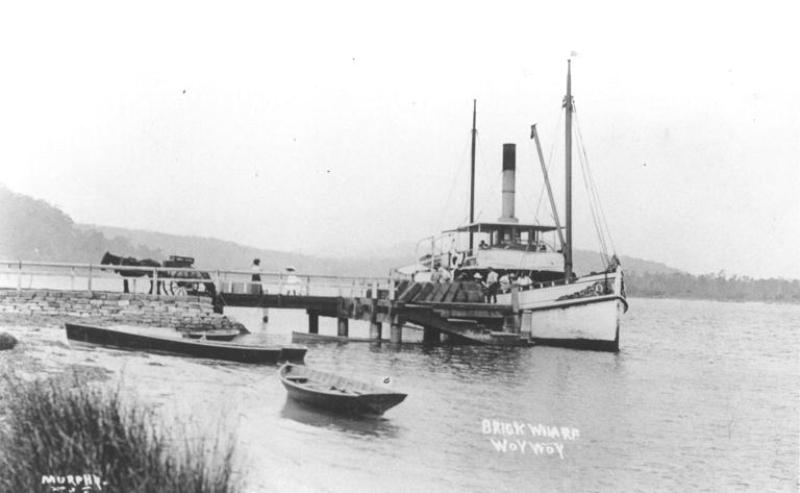
"S.S. Woy Woy" at the Brick Wharf, Woy Woy [rebuilt wharf], 74 tons, b. 1901 by William Dunn, Berrys Bay, N.S.W.
Candles having been provided, the ladies were put on a trolly and taken as far as practicable. Here were the workings, and those who were fortunate enough to be there saw something to remember for their lifetime. By the lurid light of candles, arranged much like the fanlight in the roof of a theatre, were a number of men, who looked like gnomes delving in the interior of the Hartz mountain. The stupendous nature of the work could in some measure be gleaned by observing the rough, rude roof and walls and the centre opening. On either side the tunnel is bricked; but in the middle, where the last shot was to be fired, there was nothing but rugged stone, a sample of the whole mile of solid granite rock to be got through. Some of the venturesome of the party went beyond the site of the last shot, and saw in the dim awful distance what seemed to be a pin hole punctured in black paper-only a speck, but fraught with vast significance. That small hole meant an union between Occident and Orient. It connected the colonies of Australia, put Victoria, South and West Australia in communication with the more eastern and southern colonies-a connecting link of the vast continent. After the party had inspected such of the works as were unfinished, a move was made in order to place a respectful distance between them and the last shot. As they waited in breathless expectation, a series of awful bangs made the earth tremble, and caused a reverberation and vibration which led the un-initiated to fear that the bricked tunnel was about to fall upon their devoted heads. For, it seemed, several minutes, shot after shot went off, creating a boom and quivering which made one think Vesuvius had broken loose, or Tarawera was again in eruption. In the distance could at times, by the vivid glare of the explosion, be seen huge masses of rock being hurled about like marbles by the hands of invisible Titans. There was an awe which stilled the most loquacious, and it was with a feeling of relief that a start was made for the northern opening. That reached, Mr. Reeve, with the rest of the guests, mounted a truck and delivered an oration. Mr. Reeve is a scholar as well as a gentleman. For years before he got his present appointment he was on the Sydney press, and held a position as curator of the museum of antiquities attached to the Sydney University. In his speech, alluding to the gigantic undertaking that day practically accomplished by Mr. Blunt and his merry men, he told of the ways of the old Romans, which had been shown him when he was a boy by his father-works which had survived a people who, as a people, had now no existence, and whose language even is only a memory in vogue simply among scientists. He then called for cheers for the men-the bone and sinew of the undertaking ; and the “brave Rodneys" advanced to an attack upon a substantial array of barrels of good, fresh and corned, backed by sundry barrels of good old English ale. The visitors and their entertainers then left for the schoolhouse, which was prettily decorated, where a dinner was laid which would shame many metropolitan caterers ; but in the country one gets so much younger poultry and juicier pig meat that this is not to be wondered at.
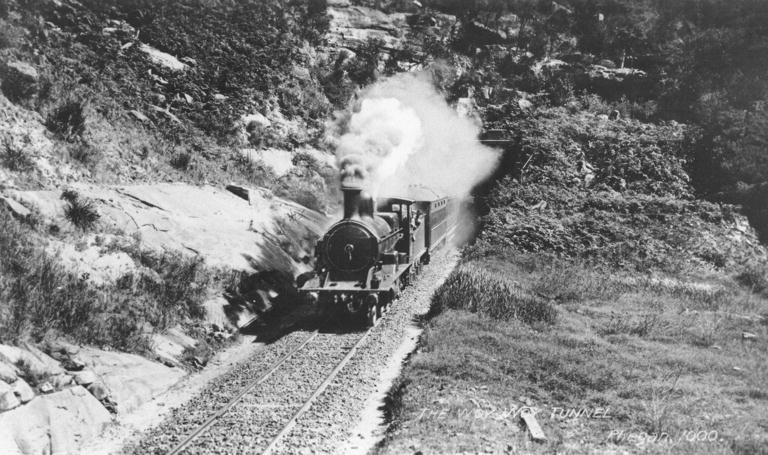
Dinner over, the chairman, still Mr. Edward Reeve, P.M., gave the usual loyal toasts, which were drunk with great enthusiasm. He then proposed" The Parliament of New South Wales," and the local member () responded first. Mr. Scott, piqued by the repetition of Mr. Neild's interjection in the House that he was the honorable member for Barrenjoey, made a telling speech; in fact, he was never happier, and he was applauded liberally throughout. Mr. Butcher then gave a taste of his quality, and Mr. Hassall entered into an elaborate defence of the Government policy, claiming the honor of himself excluding the Press in the interests of good legislation. At the conclusion of his really good speech he called for bumpers, and gave "Mr. Blunt " as a toast, pointing to the stupendous nature of the undertaking.
Mr. BLUNT, in reply, entered into some of the difficulties of the work. It cost, he said, £1000 a month to supply air to the workmen in the tunnel; but they had it, and would have had it if it had cost£10,000. It was a tough job-the toughest he had ever tackled ; but it was now, as a matter, of fact, done, and he thanked the company for the evident heartiness of their appreciation of his labors, though they mustn't forget his men.
Mr. HAROLD STEPHEN then proposed, briefly, the superintending engineer and his staff, and Mr. Nicols said it had never been his pleasure to overlook a better or more honest piece of work carried out for the Government. It was impossible under the plan of supervision for contractors to " skimp " work, but in this instance the contract specifications had been cheerfully, and without any interference, carried out. An unrehearsed effect took place here. Mr. George Mackie, one of the working managers, unaware of the fact that Mr. Brunt's health had been drunk-having been away preparing statistics for the reporters-said the company mustn't forget George Blunt. The secret of his success-and he had undertaken some of the big Government contracts in New South Wales-was that the men considered him as one of themselves. No one could over accuse him of any dishonorable act, and he had the keenest sympathy with the humblest of his employees. This was proved by the fact that numbers of the men on the contract had been with him when he had the Picton, Sodwalls, and Goulburn to Gunning jobs. Mr. Mackie's was a characteristic, manly, workingman's speech, which was received with much applause. " The Ladies" and " the Press" were the last toasts, the imperative whistle of the steamer precluding the possibility of toasting the chairman. Three cheers, however, were given in all heartiness as the steamer left the wharf for Mr. Edward Reeve, who contributed in no small degree to the success of the whole affair. The Circular Quay was reached at about 7.30 p.m.
Some statistics in commotion with the work were furnished. Length of tunnel, 1 mile 4 chains ; excavation of rock, 124,500 yards ; bricks used when complete, 10,000,000 ; casks of cement, 10,000; gun-powder used in blasting, 110 tons ; dynamite 10 tons. Ten percussion drills were used, driven by compressed air supplied through a 5in pipe by means of an engine of 40-horse power, the pressure being 200lb to the square inch. The shots were put in some 27 or 30 at a time. To supply air to the men one of Root's 10-horse power blowers was driven at the mouth. Eight hundred men have been employed ; 300 of them were always on the tunnel. About 900 navvies are to be employed on the extension of the railway to Hergott Springs, S.A. Homebush-Waratah Railway. (1886, July 24). Australian Town and Country Journal (NSW : 1870 - 1907), p. 30. Retrieved June 4, 2013, from http://nla.gov.au/nla.news-article71065668
1886 was also yet another year marked by the Charlotte Fenwick charging into contact with other ferries, one of numerous occasions when this occurred throughout her career, but balanced out by the number of vessels whose aid she came to;
A collision took place yesterday evening sear the Circular Quay between the steamers Wallaby and Charlotte Fenwick, when the latter sustained considerable damage. NEW SOUTH WALES. (1886, September 11). South Australian Weekly Chronicle (Adelaide, SA : 1881 - 1889), p. 21. Retrieved from http://nla.gov.au/nla.news-article93841313
The photo here, from this era, shows how many ferries were using Circular Quay and could explain why a little bumping off each other regularly occurred.
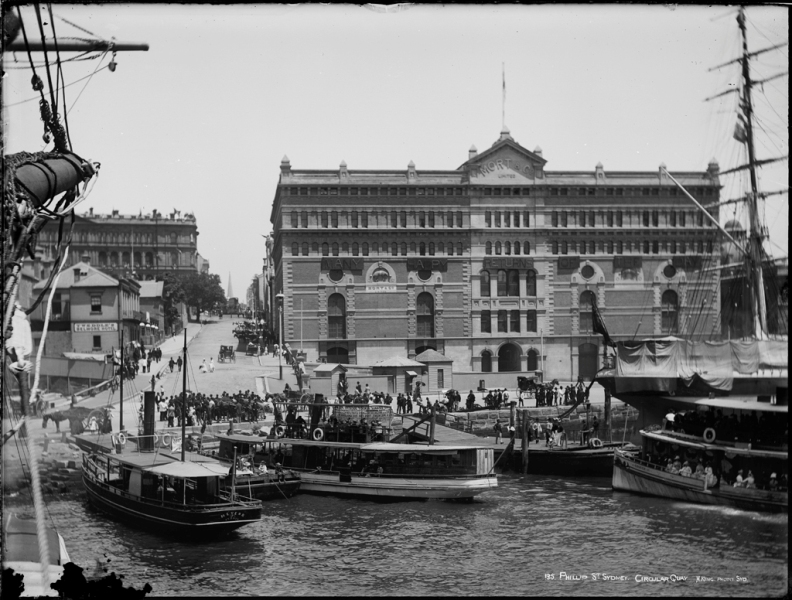
Phillip Street, Sydney - Circular Quay, Anniversary Day Thursday 26 January 1888
Trade to and from the Central Coast, up the Hawkesbury River and Pittwater so increased in volume that:
BRISBANE WATER. A deputation was introduced to the Minister for Works yesterday by Mr. Stevenson, M.L.A., in reference to the dredging of Brisbane Water. In pointing out the importance of the matter, and alluding to the inconvenience caused, Mr. Stevenson quoted a number of figures relating to the passenger and cargo traffic. In regard to the Peats Ferry and Gosford steamer placed on that line since the opening of the Gosford-Newcastle section there had been from the 16th to the 23rd August 256 persons travelling, which had in no visible way interfered or diminished the usual steamer average, proving that they had been persons who do not belong to Gosford or the ordinary Gosford travellers, but rather those who would not make a sea passage and are residents of Newcastle and northern districts. From what he heard from various sources after the route was better known the number would, he was assured, be largely increased. The steamers had had great difficulties; in crossing the bar. It was hard that something had not been done to it and the river in the interest of navigation before this, particularly when the fact exists of such a, traffic being carried on. The following figures were quoted as showing the amount of passenger traffic :- Number of passengers that had travelled to and from Gosford and Sydney from January 1st to 31st July, 1887, in the steamers Gosford, Charlotte Fenwick, Promise, and Defiance, 10,645 adults. Taking the average for three years to 31st July, 1887, there had been per annum 20,000. With regard to goods, the same dates for the last three years, goods had been shipped to the amount of per annum 5000 tons. These particulars applied solely to the steamers Gosford, Charlotte Fenwick, Defiance, Promise, and Genists. Of other vessels trading to that place, there were the steamers Emperor, Greyhound, Ena, Squirrel, and the ketches Maggie Riley, Day Dawn, Australian, Venus, Mary Davis, Jonathan, Teresa, and others.
Mr. SUTHERLAND admitted the importance of the information, and promised to give it his earnest consideration. BRISBANE WATER. (1887, October 8). The Sydney Morning Herald (NSW : 1842 - 1954), p. 9. Retrieved from http://nla.gov.au/nla.news-article13662687
Searle Winner by Two Lengths; The Coming Champion. SYDNEY, FRIDAY. THE race between Searle (Clarence) and Stansbury was rowed this afternoon. The weather was decidedly against outdoor amusements ; rain fell just before the time the steamers started for the scene of the contest, Parramatta. Notwithstanding that the Gosford charged 10s, and the Charlotte Fenwick 5s, they were crowded, besides several smaller vessels. The rain cleared off. When the river was entered very few persons were found, to -be-.congregated on the various vantage sites, in consequence of the threatening aspect of the weather. On leaving the Circular Quay the betting was greatly in favour of the Clarence champion, 2 to 1 being laid on him ; and 7 to 4against Stansbury. The same prices were quoted at the starting post. The start was by mutual consent; Stansbury had a slight lead, but Searle soon overhauled him and at half a mile was leading by half a length, and at the milepost he increased his lead to a length, when his opponent spurted, but with no avail. From here to the finish Searle led as he liked, increasing the lead from one to three lengths, winning eventually by a couple of lengths. Time, 19.52 (the fastest ever rowed over the Parramatta River in a match) A quarter wind and tide was greatly in favor of the scullers. A considerable amount of money changed hands, both being heavily backed; The win was very popular. Rain came on again immediately the race was over. Boat Race. (1888, July 14). Clarence and Richmond Examiner and New England Advertiser (Grafton, NSW : 1859 - 1889), p. 5. Retrieved from http://nla.gov.au/nla.news-article62094637
AQUATICs. KEMP AND SEARLE. The steamers Gosford and Charlotte Fenwick conveyed a number of people up the Parramatta River on Saturday afternoon to see the scullers at work. Kemp went down the stream with Stansbury, and gave as magnificent an exhibition of sculling as has over been witnessed on the home waters. Although there was a strong head wind, his rowing was clean and hard, and ho exhibited splendid watermanship, and got plenty of pace out of his shell. The ease with which he rowed was truly remarkable, and was very favourably commented on by the spectators. Searle, who was out with Masterson, also performed splendidly, indulging in several brilliant spurts at about 40 strokes to the minute, his rowing being very effective and decidedly last. Both men looked in the very best of condition, and from the magnificent exhibition of rowing given on Saturday the result of the forthcoming struggle is considered by good judges to be very much in doubt. AQUATICS. (1888, October 22). The Sydney Morning Herald(NSW : 1842 - 1954), p. 4. Retrieved from http://nla.gov.au/nla.news-article13700532
Australian Rowing and Championship sculling website says: World Professional Sculling Championships 1887-1888: 1888 Henry Ernest Searle (AUS) defeats Peter Kemp (AUS)—£1,000 cash purse Henry Searle. So sure were local backers of Searle, they sought to challenge Kemp for £5,000. The champion was content to make the bet £500. The race was a walkover with Searle winning by 150 yards. Retrieved from: http://www.rowinghistory-aus.info/world-pro-sculling/1887-1888.php
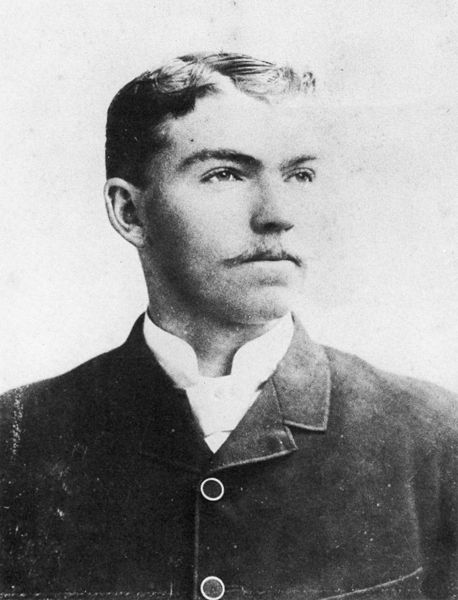 Henry Ernest Searle (1866–1889), was a professional Australian sculler, who was World Champion from 1888 until his premature death from typhoid in 1889. Born on 14 July 1866 at Grafton, New South Wales to Henry Samuel Searle, bootmaker, and his wife Mary Ann, née Brooks. The family later moved to Esk Island, lower Clarence River, where they farmed at subsistence level. After failing to get a match with the former World Champion Ned Hanlan, Searle challenged the then champion Peter Kemp (rower). On 27 October 1888 the match took place on the Parramatta River. The usual £500 a side was at stake as well as the Title. At the start Searle took the lead and although Kemp made great efforts he could never overtake the leader who won by about twenty lengths in a time of 22m.44s. Thus Searle was World Champion. Henry Ernest Searle. (2012, November 14). In Wikipedia, The Free Encyclopedia. Retrieved from http://en.wikipedia.org/w/index.php?title=Henry_Ernest_Searle&oldid=522962684
Henry Ernest Searle (1866–1889), was a professional Australian sculler, who was World Champion from 1888 until his premature death from typhoid in 1889. Born on 14 July 1866 at Grafton, New South Wales to Henry Samuel Searle, bootmaker, and his wife Mary Ann, née Brooks. The family later moved to Esk Island, lower Clarence River, where they farmed at subsistence level. After failing to get a match with the former World Champion Ned Hanlan, Searle challenged the then champion Peter Kemp (rower). On 27 October 1888 the match took place on the Parramatta River. The usual £500 a side was at stake as well as the Title. At the start Searle took the lead and although Kemp made great efforts he could never overtake the leader who won by about twenty lengths in a time of 22m.44s. Thus Searle was World Champion. Henry Ernest Searle. (2012, November 14). In Wikipedia, The Free Encyclopedia. Retrieved from http://en.wikipedia.org/w/index.php?title=Henry_Ernest_Searle&oldid=522962684
PERKINS V. LIBEAU.-The outrigger race for £100 a side between George Perkins, the English ex-champion, and Don Libeau, who has made a name for himself on the track, and has now turned his attention to aquatic exorcises, took place on Saturday afternoon. The course was the Parramatta championship course. As was generally anticipated, Perkins won as he liked, although, had the weather been different the newcomer would, perhaps, have made a hotter "show." The wind was blowing hard from the south, which made the water very rough in most places along the river. The steamer Charlotte Fenwick, with the umpire(Mr. J. Blackman) and a fair number on board, followed the race. Libeau won the choice of position, and took the southern side. Shortly after starting Libeau wont in too close, and got foul of the mud, which allowed Perkins to fet some distance ahead of him. On getting clear of Uhr's Point the rough water completely worried Libeau, and also gave Perkins no little amount of trouble, as he had to pull in and out of all the southern bays to get as much lee as possible. It was merely a paddle after this, and could not be termed a race. Perkins passed the winning post in 80min 86sec, having pulled perhaps a mile and a half more than the course really is. Libeau finished about half a dozen lengths behind his opponent. Notes for "Neptune.". (1888, December 29). Australian Town and Country Journal (NSW : 1870 - 1907), p. 36. Retrieved from http://nla.gov.au/nla.news-article71105890
FENWICK.-March 5, 1889. at her parents' residence , Belmore House, Belmore, after a short illness of four hours, Eve-line, youngest beloved daughter of John and Pauline Fenwick, aged 7 years and 2 months. Safe from the world's temptations, sin cannot harm her there. Family Notices. (1889, March 9). The Sydney Morning Herald(NSW : 1842 - 1954), p. 1. Retrieved from http://nla.gov.au/nla.news-article13716860
COASTERS OUTWARDS.-JULY 20. White Cloud, for Brunswick River; Sea Nymph, for Manning River; Charlotte Fenwick, Rosedale, Venture, coast –wise COASTERS OUTWARDS.—JULY 20. (1889, July 22). The Sydney Morning Herald (NSW : 1842 - 1954), p. 6. Retrieved from http://nla.gov.au/nla.news-article28336749
HAWKESBURY~RIVER~BROKEN~BAY: Peat's Ferry, Bar Point, Pittwater, and Newport. S.S. GRAND leaves Market Wharf at 10 30 a.m. daily. Cargo at very low rates received daily. HAWKESBURY Excursion steamer SAPPHIRE, SATURDAY and SUNDAY", after arrival of Morning trains. OSCAR SCHULTZE.
GOSFORD AND BRISBANE WATER:S.S. CHARLOTTE FENWICK will leave every TUESDAY and FRIDAY from Patent Slip Wharf, Lime-street, off Erskine-street, at 8 am. From Gosford, 1.30 p.m. Fares-4s single, 6s return FOR HAWKESBURY RIVER".
S S. CHARLOTTE FENWICK will leave every SUNDAY and WEDNESDAY, at 8a.m., taking Cargo and Passengers. Freights payable In Sydney. HAWKESBURY RIVER, BROKEN BAY: Peat's Ferry Bar Point Pittwater, and Newport.
S.S. GOSFORD leaves Patent Slip Wharf at 9.30 a.m. daily, taking Passengers and Cargo. Freights payable in Sydney. FOR NEWPORT WHARF BAR POINT: and MANGROVE WHARF. S.S. GOSFORD. DAILY from Patent Slip Wharf, at 9.30 a.m., taking passengers and Cargo. Freights payable in Sydney. Advertising. (1890, January 11). The Sydney Morning Herald(NSW : 1842 - 1954), p. 1. Retrieved from http://nla.gov.au/nla.news-article13755871
CHARLOTTE FENWICK. [BY TELEGRAPH.) FROM OUR CORRESPONDANT
WISEMAN'S FERRY, FRIDAY. The steamer Charlotte Fenwick, from Sydney, passing here on Wednesday last for Sackville, met with a mishap. When up the river, it appears the hawser by some means got round the propeller, and thus disabled the boat. As the obstruction could not be removed, the steam launch Binghie was sent for, and just now passed here with the Charlotte Fenwick in tow, bound for Peat's Ferry, where the disabled steamer will be beached in order to clear the propeller, enabling her to return to Sydney. ACCIDENT TO THE STEAMER CHARLOTTE FENWICK. (1890, March 29). The Sydney Morning Herald (NSW : 1842 - 1954), p. 12. Retrieved from http://nla.gov.au/nla.news-article13765136
Meanwhile in Victoria:
WANTED, at once, a few SHIP CARPENTERS, or men handy with tools. Apply J. Carpenter and Son, Lakes Entrance. Advertised Saturday 12th of June 1886 in Bairnsdale Advertiser and Tambo and Omeo Chronicle.
THE LAKES' ENTRANCE. The tender of Messrs J. Carpenter and Son has been accepted for works at the new entrance to the Gippsland Lakes. The amount is £6,891. THE LAKES' ENTRANCE. (1888, September 28). Gippsland Times (Vic. : 1861 - 1954), p. 3 Edition: Morning.. Retrieved from http://nla.gov.au/nla.news-article62241905
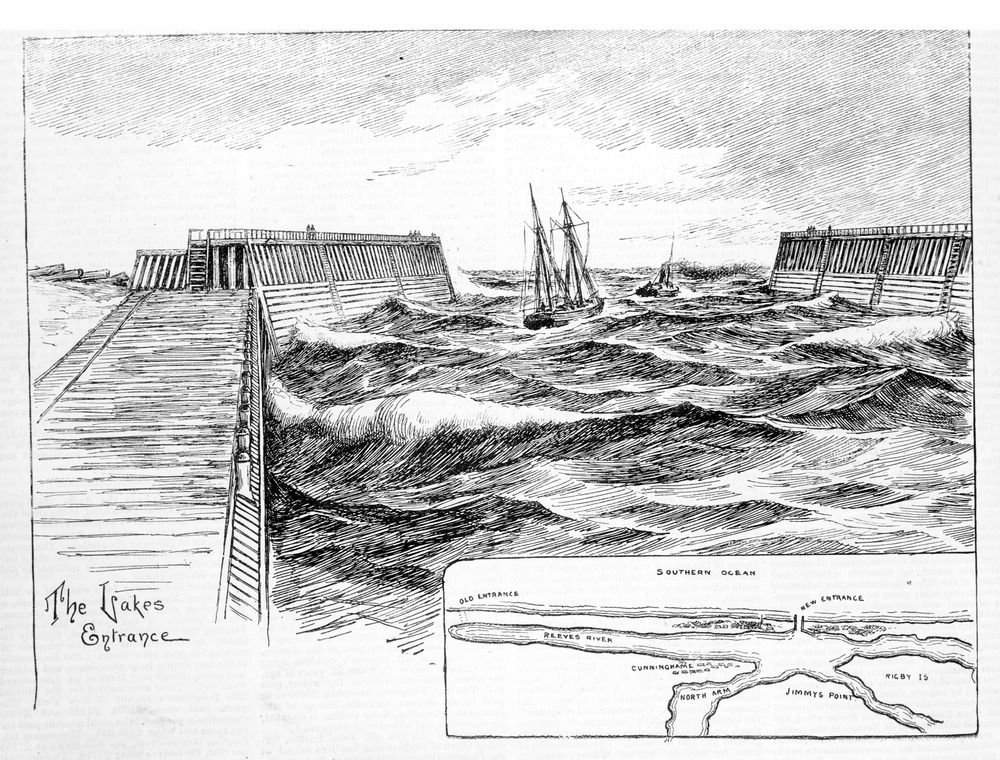
GIPPSLAND LAKES ENTRANCE. [picture] Publisher: Melbourne : David Syme and Co. Date: Mar. 1, 1892. Description: print : wood engraving. Notes: Prints published in the Illustrated Australian news. Title taken from article this image illustrates. Link to digitised item: http://handle.slv.vic.gov.au/10381/255927
It is reported that a company has been formed, or which Mr J. Carpenter, of Lakes' Entrance, is a member, for the purpose of trading between Sale and Melbourne. We have no definite information on the subject, but the report is that the company will start with a steamer and two schooners. The Gippsland Times. (1890, June 13). Gippsland Times (Vic. : 1861 - 1954), p. 3 Edition: Morning.. Retrieved from http://nla.gov.au/nla.news-article65297391
OBITUARY JAMES ARTHUR CARPENTER. The death occurred on Thursday last of Mr. James Arthur Carpenter, at the age of 69 years. Born at Yarram, the deceased gentleman has resided at the Entrance for the past 24 years and he and his Wife and family have enjoyed the esteem and respect of a very large circle of friends. The late Mr. Carpenter's father, John Carpenter, was the contractor for building a section of the original piers for the Entrance to the Gippsland Lakes., The late Mr. Arthur Carpenter at that time held a captain's certificate and was in charge of the "Bogong" and "Fenwick,” which were carrying stone from the Nicholson River to the piers. The family originally came from Maffrato Lakes Entrance. The deceased gentleman is survived by his wife and two sons and one daughter, viz.: James, Fred and Dorothy. One daughter, the late Mrs. Lougden, is deceased. The funeral took place on Saturday afternoon and was largely attended by district residents. Many floral tributes were placed on" the coffin. The services at Church of England and at the graveside were conducted by the Rev. N. A. McLean. OBITUARY. (1934, October 18). Gippsland Times (Vic. : 1861 - 1954), p. 8. Retrieved from http://nla.gov.au/nla.news-article62677299
An old and respected resident of Gippsland has joined the great majority. We refer to Mr .John Carpenter, who for years past has been connected with the works at the Lakes Entrance. Deceased had reached the ripe age of 77., In days gone by the late Mr Carpenter was in business in Sale, after which he removed to Maffra, carrying on an extensive flour-mill business there. He was also a 'valued member of the Maffra shire council, and on leaving that district for the Entrance he was made the recipient of a handsome present by the townspeople. Deceased remains will be brought to Sale today in the Charlotte Fenwick and interred in the Sale general cemetery this afternoon', the funeral procession leaving' the-canal wharf at 2 o'clock. The Gippsland Times. (1891, November 18). Gippsland Times(Vic. : 1861 - 1954), p. 3 Edition: Morning.. Retrieved from http://nla.gov.au/nla.news-article65306303
John (James) CARPENTER was christened on 19 Jan 1814 in St Peters, Tiverton, Devon, England. He died in 1891. He married Sarah Churchward LEIGH in 1856. He emigrated to Victoria, Australia in the 1850's. He settled in Yarram and is considered to be the founding father of the town, starting the first industry there - flour & timber mills. He also farmed and subdivided land. JC then moved on to the Walhalla gold mining area and set up quartz crushing machinery. After that there were flour mills at Maffra and Heyfield. In partnership with nephew James Henry CARPENTER (b.1841) for a short time, also with his cousin William's son John Waller CARPENTER (b.1850). Finally JC took a contract to build the entrance at Lakes Entrance and became involved in shipping in the area. Sarah Churchward LEIGH was born in 1827. She died in 1900. She married John CARPENTER in 1856. They had the following children: George Alfred CARPENTER, Mary Alice* CARPENTER was born in 1859 in Yarram, Victoria, Australia. She died in 1859 as infant - aged: 5 months. Sarah Matilda CARPENTER, John Arthur CARPENTER, Frederick CARPENTER and Florence Elizabeth CARPENTER was born in 1868 in Sale, Victoria, Australia. She died in 1917 in East Melbourne, Victoria, Australia.
The steamer Charlotte Fenwick was bought by Carpenter Bros., in Sydney, to run excursion trips on the Gippsland Lakes and rivers shortly after the opening of the new entrance. 'This vessel acted as a tug boat for a few years, and was later engaged in deep-sea fishing industry between the Kent Group Islands and Melbourne. With the withdrawal of the Sale Steamboat Company's vessels, Omeo and Dargo, also the J.C.D. and Gippsland, there remains only one steamer, the Dargo, afloat on the lakes and today she is occupied as a house boat on the Mitchell River. Gippsland Shipping. (1948, December 16). Gippsland Times(Vic. : 1861 - 1954), p. 10. Retrieved June 6, 2013, from http://nla.gov.au/nla.news-article63289583
Mr. John Williams reports:-The steamer Charlotte Fenwick, a well-known Sydney vessel which for some time was running between Sydney and the Hawkesbury River, has just changed hands, having been purchased by Messrs. Carpenter Brothers, an enterprising firm of Gippsland (Victoria),for service In Victorian waters. Messrs. Carpenter Brothers have a fleet of steamers in the Gippsland Lakes district, and it is their intention to employ the Charlotte Fenwick In towing, &c., for which she will doubtless be found admirably adapted. The Charlotte Fenwick is a screw steamer of 73 tons gross, and was built at Sydney in 1883. She will leave here about Thursday next. EXPORTS.—AUGUST 4. (1890, August 5). The Sydney Morning Herald (NSW : 1842 - 1954), p. 4. Retrieved from http://nla.gov.au/nla.news-article13790012
REPORTS, The Charlotte Fenwick: leaves on Monday for the Gippsland Lakes. SHIPPING REPORTS, &c. (1890, August 9 - Saturday). The Sydney Morning Herald (NSW : 1842 - 1954), p. 10. Retrieved from http://nla.gov.au/nla.news-article13774520
She left on August 11th 1890;
The small steamer Charlotte Fenwick, bound from Sydney to the Gippsland Lakes, called in at Wollongong today for a cargo of coal, but broke her propeller shaft as she was entering the basin. She will have, to procure a new shaft from Sydney. INTERCOLONIAL TELEGRAMS. NEW SOUTH WALES. (1890, August 13). The Argus (Melbourne, Vic. : 1848 - 1957), p. 6. Retrieved from http://nla.gov.au/nla.news-article8426516
The steamer Charlotte Fenwick, recently purchased by Messrs. Carpenter Brothers, of Victoria, made a smart run down to Gippsland Lakes, arriving there on Sunday. SHIPPING AND AQUATICS. (1890, August 26). Evening News (Sydney, NSW : 1869 - 1931), p. 6. Retrieved from http://nla.gov.au/nla.news-article113339239
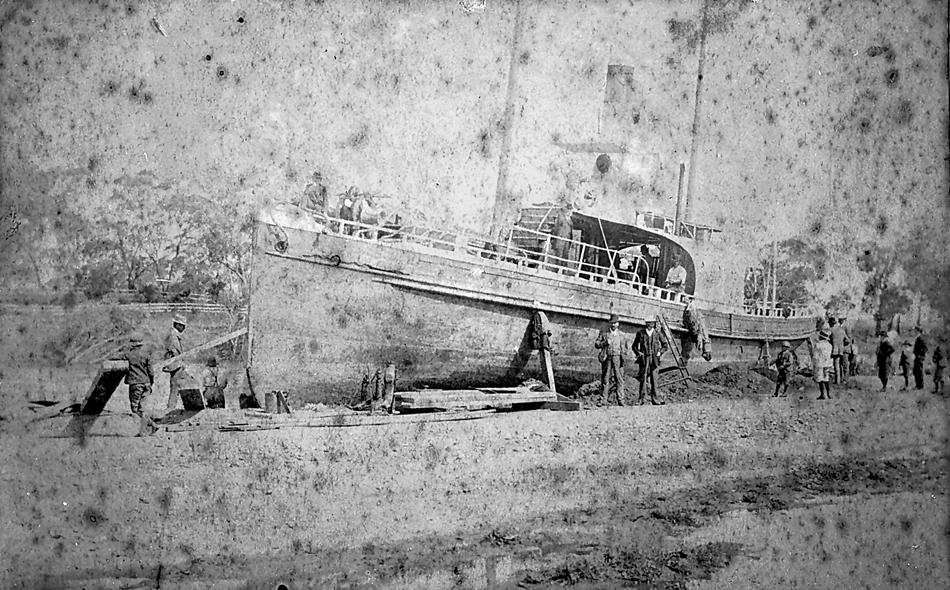
The 'Charlotte Fenwick' on dry ground. The boat is supported by props and stays and is, presumably, undergoing refitting. - Lakes Entrance, Victoria, circa 1890. Image 004652 Courtesy Museum of Victoria
The fishing craft Unique, owned by Messrs Robinson and Co., of Payneville, and under the command of Mr Carstoire, of Cuninghame, arrived off the Entrance at 8 a.m. on Friday. In order that whatever fish was aboard of her might be landed at Cuninghame in time for transhipment to the steamer JCD, which was about to leave for Bairnsdale, Messrs Carpenter and Sons, the owners of the steamer Charlotte Fenwick, very kindly sent that vessel out to sea to tow the Unique in. The latter vessel left the Entrance-about three weeks ago for Mallacoota Inlet, but the fish there was not as plentiful as was expected, owing to the recent floods. However, it was not long before Mr Carotairo was able to despatch 70 baskets by the steamer Eashy, bound from Sydney to Melbourne. The captain of the latter vessel expressed his surprise when the Unique came alongside to see a vessel of her tonnage weathering the very rough sea that prevailed at the time. The Unique then left Mallacoota and vicinity for Twofold Bay, on the New South Wales coast. THE FISHING INDUSTRY. (1890, September 3). Gippsland Times (Vic. : 1861 - 1954), p. 3 Edition: Morning.. Retrieved June 5, 2013, from http://nla.gov.au/nla.news-article65298687
PACKET LICENSES. Jas. Mill., for ss. Charlotte Fenwick. GROCERS' LICENSES GRANTED. (1890, December 20).Bairnsdale Advertiser and Tambo and Omeo Chronicle (Vic. : 1882 - 1918), p. 2 Edition: morning. Retrieved from http://nla.gov.au/nla.news-article84693913
A Packet Licence was required to sell liquor on passenger ships.
On Sunday morning, the schooner, Wellington, from Melbourne was towed into the canal basin by the S.S. Charlotte Fenwick. The Wellington brought a large cargo of merchandise for the Sale merchants. SALE. (1890, December 23). Traralgon Record (Traralgon, Vic. : 1886 - 1932) , p. 3 Edition: morning. Retrieved from http://nla.gov.au/nla.news-article59204928
A special excursion is announced to be run by the s.s. Charlotte Fenwick from Bairnsdale to the Entrance on Monday, the 26th inst. (Foundation Day). On arrival at the Entrance the steamer will proceed to sea(weather permitting) and remain outside for two hours, to give those onboard an opportunity of indulging in fishing. The return fare will be four shillings, and the trip outside a shilling extra. The Advertiser. (1891, January 15). Bairnsdale Advertiser and Tambo and Omeo Chronicle (Vic. : 1882 - 1918), p. 2 Edition: morning. Retrieved from http://nla.gov.au/nla.news-article84694140
The Inspector.General of PublicWorks, Mr R. Davidson, returned to Bairnsdale yesterday from the Lakes Entrance, after having made a thorough inspection of both piers. The result of his inspection is not known, but we understand the fears entertained of the safety of the works were not without foundation as regards the elbow portion of the eastern pier, which it appears will be a source of trouble for some time to come, owing to the continual sinkage of stone consequent upon the immense scour at that particular point. The Advertiser. (1891, June 11). Bairnsdale Advertiser and Tambo and Omeo Chronicle (Vic. : 1882 - 1918), p. 2 Edition: morning.. Retrieved from http://nla.gov.au/nla.news-article84814902
Repairs to tramway and deposit of stone, eastern pier, Lakes Entrance, J. Carpenter and & Son, £127 10s; The Advertiser. (1891, June 16). Bairnsdale Advertiser and Tambo and Omeo Chronicle (Vic. : 1882 - 1918), p. 2 Edition: morning.. Retrieved from http://nla.gov.au/nla.news-article84814948
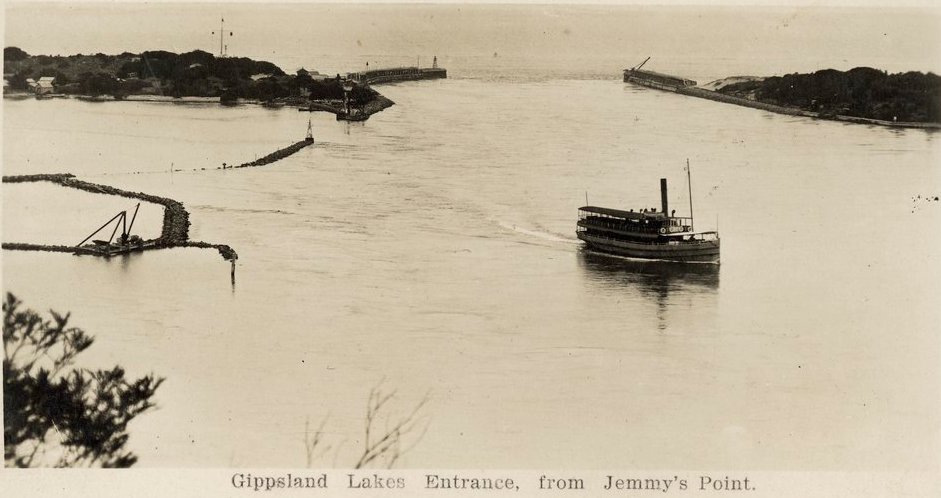
Gippsland Lakes Entrance 1929. Image No. 337697 Courtesy State Library of Victoria.
The s s. Charlotte Fenwick made a good haul of fish this week at Knot's Group, securing about 600 basketsful. She steamed straight to Melbourne with them, and reached there in time for the market yesterday morning. The Advertiser. (1891, December 24). Bairnsdale Advertiser and Tambo and Omeo Chronicle (Vic. : 1882 - 1918), p. 2 Edition: morning.. Retrieved from http://nla.gov.au/nla.news-article84817072
As a considerable amount of feeling has been created through an announcement that the-Sale branch.-A.N. A. had chartered the Charlotte Fenwick for the 26th January, 1892,- and that it is the intentions of the A.N.A. - to pose as oppositionists to our local steamboat company, I took occasion to ascertain the why and wherefore of the matter. During the early portion of the year the A.N.A. applied to the Sale steam boat company for a steamer for the 26th of January, 1892, and were informed that the directors could not see their way clear to charter a boat so far ahead, but if an application was made later in the year they would have the first offer of refusal. ''The A.N.A.' then made application in the early part of November, and the directors then fixed a charge of £25 on the boat for the day. The committee of this branch thought the charge too high, considering that they received the steamer last year for £17 10s. The committee then made the directors an offer £37 10 for two days, viz., the 26th of January and one day in March, not a holiday. This they directors refused to entertain, and then without any further negotiations on their part, chartered the steamer to another society for £25. Such being the case, the A.N.A, not to be done out of their legitimate holiday, which was secured through their instrumentality, decided to make other arrangements, which' they have done, by chartering the “Fenwick" for that day. The A.N.A. are extending their branches into all parts of the colony, and the latest niose has been in the direction of Walhalla, which speaks for itself. NOTES BY WANDERER. (1891, December 16). Gippsland Times (Vic. : 1861 - 1954), p. 3 Edition: Morning.. Retrieved from http://nla.gov.au/nla.news-article65306738
The Australian Natives' Association (ANA), a mutual society was founded in Melbourne, Australia in April 1871 as the Victorian Natives' Association. In 1872 it voted to extend membership to men born in the other Australian colonies and changed its name at the same time. The Association played a leading role in the movement for Australian federation in the last 20 years of the 19th century. In 1900 it had a membership of 17,000, mainly in Victoria. The ANA provided sickness, medical and funeral cover. However, it threw off the secrecy and ritual of British friendly societies which also provided such insurance cover. Membership in the ANA was restricted to men born in Australia, at a time when Australian-born people of European descent (not including Indigenous Australians) were rising to power in place of an older generation born in Britain. In the 1890s, for the first time, they became the majority of the population. The ANA consisted mainly of energetic middle-class men aged under 50 - a perfect base for a forward-looking, idealistic movement such as federation. Australian Natives' Association. (2013, April 19). In Wikipedia, The Free Encyclopedia. Retrieved from http://en.wikipedia.org/w/index.php?title=Australian_Natives%27_Association&oldid=551197518
1892; duties as a tug;
The schooner Marisar with over 100 tons of goods for Sale and district arrived at the canal wharf on Monday morning, in tow of the Charlotte Fenwick. The Gippsland Times. (1892, January 27). Gippsland Times (Vic. : 1861 - 1954), p. 2 Edition: Morning.. Retrieved from http://nla.gov.au/nla.news-article65307262
Upon arrival of the Sale Steamboat Co.'s steamer Dargo at Paynesville on Friday evening last, Captain Masters found the Bairnsdale steamer J.C.D. and Charlotte Fenwick lying at the wharf, as the captains considered it unsafe to continue the trip to the entrance on account of the dense fog prevailing. The Dargo continued her journey to the entrance, which she reached safely at the usual time. The J.C.D. followed in the wake of the Dargo for a short distance but put back to Paynesville and did not reach the entrance till 7.30 next morning. Upon the up trip, the Dargo and J.C.D. towed the Charlotte Fenwick off, she having grounded at Flannigan's Island during the night, while making an attempt to reach the entrance. The Gippsland Times. (1892, February 22). Gippsland Times (Vic. : 1861 - 1954), p. 3 Edition: Morning.. Retrieved from http://nla.gov.au/nla.news-article65307635
The A.N.A. trip to the Entrance, provided an enjoyable termination trip to Sale of the conference delegates. Timing was first-class, fun being the order of the day from first to last, a portion of this…. being a run out to sea on the Charlotte Fenwick. The Gippsland Times. (1892, March 11). Gippsland Times (Vic. : 1861 - 1954), p. 2 Edition: Morning.. Retrieved from http://nla.gov.au/nla.news-article65307859
The steamer Charlotte Fenwick, owned by Mr G. Carpenter, of the Lakes' Entrance, has lately been employed in deep sea fishing with very successful results. On Monday morning the Charlotte Fenwick arrived at the Queen's Wharf, Melbourne, with 15 tons of salmon, the result of a haul made in Waterloo Bay. THE Maffra Spectator. (1892, September 8). The Maffra Spectator (Vic. : 1882 - 1920), p. 3. Retrieved from http://nla.gov.au/nla.news-article66858671
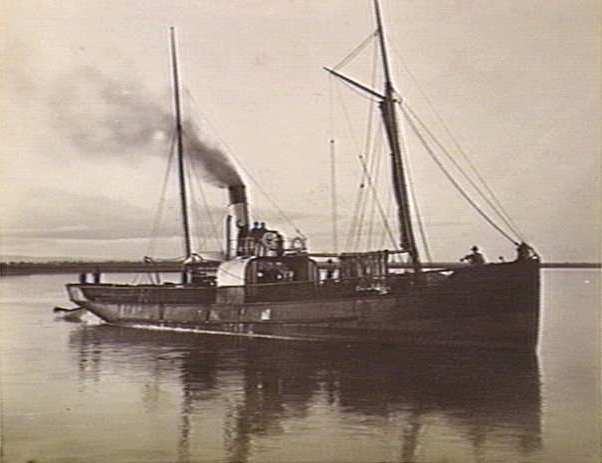 Left: Fishing Boat on Gippsland Lakes, 1890. Image no b24057, courtesy State Library of Victoria.
Left: Fishing Boat on Gippsland Lakes, 1890. Image no b24057, courtesy State Library of Victoria.
THE CHARLOTTE FENWICK.(To the Editor of the Gippsland Times.)SIR,.Rumours having been circulated and the attention of the police drawn to the matter, that the Charlotte Fenwick is not licensed or has not life belts on board, I was instructed to write to Messrs Carpenter Bros, and the following memo was received this afternoon which ought to be satisfactory to all:" Cuninghame. January 21st. 1893. "Secretary A.N.A., Sale Branch." Dear Sir,-In reply to your memo. Of 20th inst., re the Fenwick not having sufficient life belts, this is not true, as we have more than we are required to carry by the Marine Board. As to the license. we are allowed to navigate any part of Bass' Straits without passengers, and our usual number inside. yours truly, CARPENTER BROS. J. L. REECE. CORRESPONDENCE. (1893, January 25). Gippsland Times(Vic. : 1861 - 1954), p. 3 Edition: Morning.. Retrieved from http://nla.gov.au/nla.news-article62299980
supplying and depositing 4,000 tons of granite rubble at new entrance, Gippsland Lakes Carpenter Bros , £2 254 5s No Title. (1893, February 18). Bairnsdale Advertiser and Tambo and Omeo Chronicle (Vic. : 1882 - 1918), p. 2 Edition: morning.. Retrieved from http://nla.gov.au/nla.news-article91898664
SHIPPING. CUNNIGHAME. Monday. Sailed, steamer Waratah; arrived, steamer Charlotte Fenwick. Depth of water on new Entrance-Outer bar 16ft ; inner bar 11ft. SHIPPING. (1893, September 12). Bairnsdale Advertiser and Tambo and Omeo Chronicle (Vic. : 1882 - 1918), p. 2 Edition: morning.. Retrieved from http://nla.gov.au/nla.news-article91898411
By 1892 she was being regularly chartered for fishing trips to Flinders Island and by 1895 was being advertised as a fishing steamer. At this time she was also operating out of Launceston.
STEAMER CHARLOTTE FENWICK STRANDED. On Friday the steamer Tanjil, belonging to Mr Dablsen, took refuge near the willows, and the steamer Charlotte Fenwick, belonging to Messrs. Carpenter Bros., but at present under charter to the Public Works department as tug boat, etc., for the dredge Wombat, took up a position there also. During Friday night the Fenwick was driven on to the Eagle Point road, and became stranded, and now lies high and dry on the road. The task of slipping her into the river will be an expensive one, and will have to be borne by the Government. STEAMER CHARLOTTE FENWICK STRANDED. (1894, January 4). Bairnsdale Advertiser and Tambo and Omeo Chronicle (Vic. : 1882 - 1918), p. 3 Edition: morning.. Retrieved from http://nla.gov.au/nla.news-article91895518
Mr Reginald Murray, of the Mines department, accompanied by Mr Foster, the member for Gippsland East, will, it is stated, arrive in Bairnsdale today and proceed to Mallacoota Inlet in the steamer Charlotte Fenwick to inquire into the recent gold discovery there and report as to the prospects of that district as a field for miners. No Title. (1894, April 14). Bairnsdale Advertiser and Tambo and Omeo Chronicle (Vic. : 1882 - 1918), p. 2 Edition: morning.. Retrieved from http://nla.gov.au/nla.news-article91894433
Mallacoota is a small town in the East Gippsland region of Victoria, Australia. Prehistory the area was part of the territory of the Bidawal people. Settlers started to arrive in the 1830s. A small timber lighthouse was installed on nearby Gabo Island in 1854, and the existing granite lighthouse was completed in 1862. By the 1880s commercial fishing was well established, with some catch being shipped south to Melbourne. At the same time the first tourists started to arrive. The closest large town, that locals go to for things like shopping, banking, is Eden in NSW. Gold was discovered in 1894, after which the Spotted Dog Mine operated for three years. Mallacoota, Victoria. (2013, May 18). In Wikipedia, The Free Encyclopedia. Retrieved from http://en.wikipedia.org/w/index.php?title=Mallacoota,_Victoria&oldid=555663424
… yesterday morning the Charlotte Fenwick, which had been to Kent's Group, and intended to run into Melbourne, had through stress of weather to come to Bairnsdale instead, arriving here in time to catch the 5.40.a.m. train. She had 124 scoops (equal to about 240 small baskets) of trevalla, the first of this season's catch of this much-esteemed fish. The Advertiser. (1894, September 27). Bairnsdale Advertiser and Tambo and Omeo Chronicle (Vic. : 1882 - 1918), p. 2 Edition: morning.. Retrieved from http://nla.gov.au/nla.news-article86389875
LAKES ENTRANCE, Friday. Arrived, ketch Ethel B.T., s. Charlotte Fenwick. SHIPPING. (1894, September 8). Bairnsdale Advertiser and Tambo and Omeo Chronicle (Vic. : 1882 - 1918), p. 2 Edition: morning.. Retrieved from http://nla.gov.au/nla.news-article86389199
News came to Sydney yesterday of the whaling brig Phillis. She proceeded south from here to the Kent Group, and she was there fallen in with the steamer Charlotte Fenwick. The brig had been anchored six days at the Kent Group, and when the Charlotte Fenwick arrived Captain Young took advantage of the opportunity and towed to sea on the 12th instant. Captain Young intends trying for whales on the Tasmanian coast, as they are rather plentiful there at present. Maritime Miscellany. (1895, May 23). Evening News (Sydney, NSW : 1869 - 1931), p. 2. Retrieved from http://nla.gov.au/nla.news-article108096592
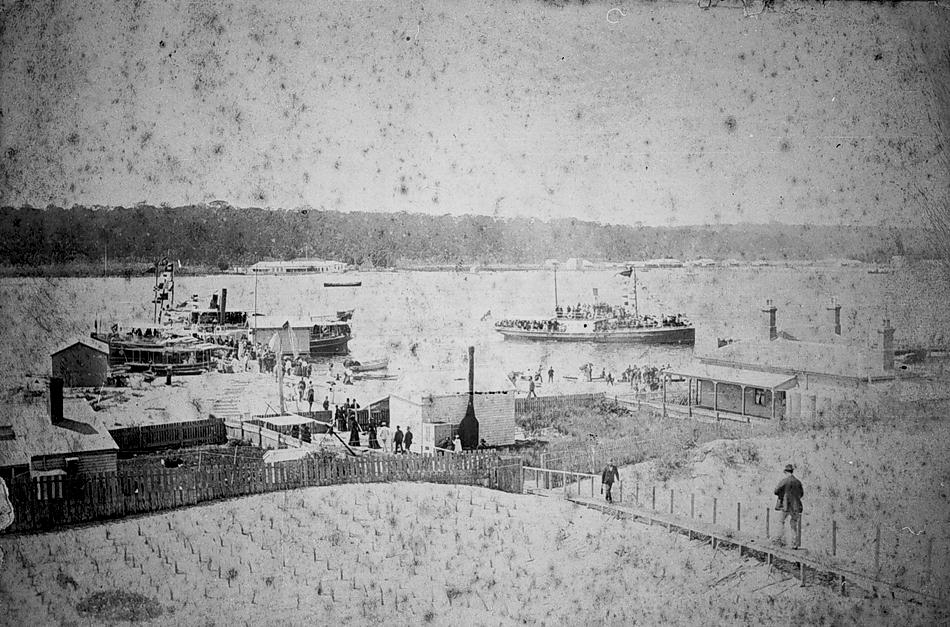
Three boats, the 'Omeo', the 'J.C.D.' and the 'Charlotte Fenwick' at Lakes Entrance, Victoria, circa 1895, Image No. 4646 courtesy Museum of Victoria.
While researching the Charlotte Fenwick we came across one of her old logs from 1897 being offered for sale on the Internet via ebay and. Although we cannot afford how much is asked for this log, the seller has kindly offered a few of the entries as insights into these years for the Charlotte. She was mainly fishing, without a day off. Extracts:
Antique Ships Log 1897 SS Charlotte Fenwick Australian Steamship Melbourne Ferry
This Ships Log is a unique treasure, a blow by blow account of a year on the sea sailing around the Victorian Coast with Captain Anderson in the year of the Diamond Jubilee of Queen Victoria 1897. In this year the boat was fishing predominately around the Kent Group of Islands, 50km South of Wilsons Promontory where they would fish with a seineboat and seine nets. They had some Garfish nets stored in tan pots on the islands at Bullie cove where they also bought provisions of mutton from the local sheep farmer on the island. They fish in lighthouse and Garden cove. They visited the major ports of Bairnsdale, Port Albert, Lakes Entrance and Portsea. Other favourite fishing spots for the boat that year were the Glennies, The Hogan Group, Oberon Bay, Smugglers cove and other locations on the Promontory and in Port Phillip Bay places like Flinders, Davey's Point etc. They worked very hard for their catch and then seemed to spend all night sailing back to Melbourne for the Friday and Tuesday fish markets in Melbourne.
Captain Anderson lists day by day the amounts and types of fish caught also noting latitude and longitude sea conditions and winds.
I just discovered a page listing the bearings from the Yarra mouth to Tasbuoy (Tasmanian buoy) Tasbuoy to Pierhead all the way to Port Albert in 19 headings with further bearings To Gabo Island, Grim head and Disaster Bay which was another favourite fishing spot.
Almost the entire year is complete; it goes from Jan 1 to December 15 without a day off, apart from the celebration for the Diamond Jubilee of Queen Victoria. There are partial financial accounts for March and October and the complete dimensions of the ship on the last page. This is just one year out of the life of the ship which in previous years , was a ferry in Sydney, and was later to a ferry around Bairnsdale and Lakes Entrance. Between 1903 and 1913 she travelled the Melbourne to Sorrento to Portsea to Queenscliff route daily. Retrieved from: http://www.ebay.com.au/itm/Antique-Ships-Log-1897-SS-Charlotte-Fenwick-Australian-Steamship-Melbourne-Ferry-/170920047032
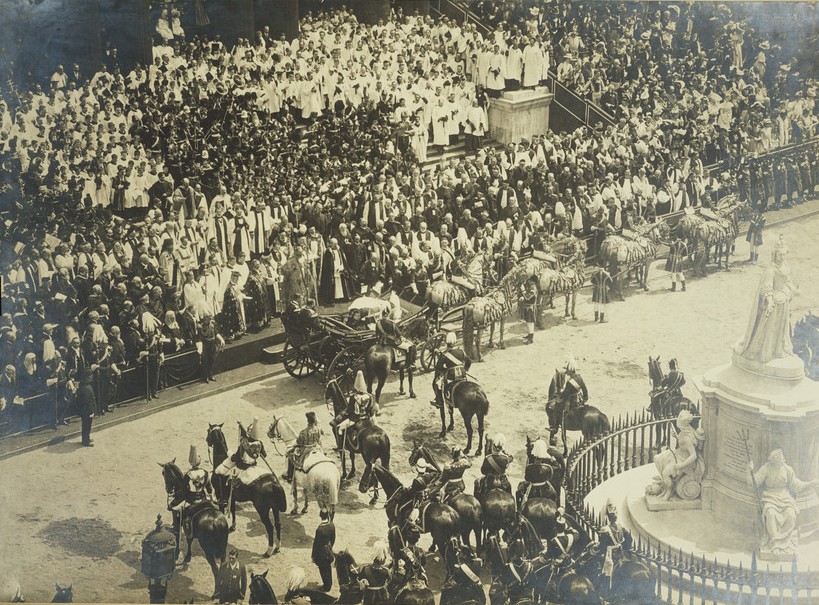
The procession for Queen Victoria's Diamond Jubilee on June 22, 1897 was one of the greatest military parades of all time. The six-mile route through London was thronged by spectators, and millions of people witness the incredible spectacle. Here she is shown arriving at St Paul's Cathedral prior to the Thanksgiving Service in honour of her Diamond Jubilee. She is sitting in the carriage, holding an umbrella, along with her daughter Princess Helena and Alexandra, Princess of Wales. Supplied by Royal Collection Trust / © Her Majesty Queen Elizabeth II 2012
A steamer, supposed to be the Charlotte Fenwick, arrived at Kangaroo Island on the 16th inst., proceeding down the Sound the following day (Tuesday). DEC. 24. The fishing steamer Charlotte Fenwick left Green Island for Mellourne on Saturday, the 22nd instant, with 95 scoops of fish. She had a lady and gentleman from Melbourne on board, also Mr A. C. Hauland, from here on a visit to Melbourne. The Charlotte Fenwick is to have new boilers put in after this trip, and does not expect to visit the Straits again till about March. COUNTRY NEWS. (1896, January 1). Launceston Examiner (Tas. : 1842 - 1899), p. 3. Retrieved from http://nla.gov.au/nla.news-article39623494
The Charlotte Fenwick the other day reported that the Phillis was in Sealers' Cove. SHIPPING. (1897, February 1). The Brisbane Courier (Qld. : 1864 - 1933), p. 3. Retrieved from http://nla.gov.au/nla.news-article3644664
Adelaide Steamship Comp: http://www.samemory.sa.gov.au/site/page.cfm?u=728#e1550
THE GLENELG DISASTER. RETURN OF THE CHARLOTTE FENWICK. CUNNINGHAME, Friday. The Charlotte Fenwick left here at daybreak yesterday morning for Gabo Island, where, strange to say, the wreck had not been heard of. She arrived at Gabo at 7 o'clock last night and returned at daybreak to-day, and both there and back kept a good look-out close in shore, but nothing was seen. The meat safe of the Glenelg came ashore to-day, about two miles east of Mr. Barton's residence, Ocean Grange, and about 12 miles west of the Entrance, but no bodies or any other wreckage were found. The volunteers, Messrs. Jemmeson , Carpenter, Seymour, and Cameron had considerable trouble, and ran a great risk in getting their boat through the surf to the Charlotte Fenwick, Jemmeson having to swim with a line to the others. A pathetic incident in connection with the return of the Charlotte Fenwick is that immediately she arrived, Jemmeson had a summons to the bedside of his father, who is dying in the Bairnsdale Hospital. The Charlotte Fenwick was placed at the disposal of the family by Messrs. Carpenter Bros. A collection is being made here for the survivors, Messrs. Bundy, Lamb, and Thorne.
THE LATE CAPTAIN ENGLISH WARRNAMBOOL, Friday.
Captain T. H. English, of the wrecked steamer Glenelg, was well known to those accustomed to made the journey from Warrnambool to Melbourne by boat. For many years he was purser on the Julia Percy, and later chief officer of the Dawn and second officer of the Flinders. When he acted as sailing master to Lord Brassey he brought the yacht Sunbeam from Melbourne to Warmambool. Flags were lowered to half mast on the Derwent on Thursday when lying in Lady Bay, and also on the offices of Messrs. John McIlwraith and Wm. Howard Smith and Sons Proprietary Limited, in memory of the captain who met his fate so gallantly.
Amongst the list of the lost appearing in "The Argus" was also Peter Bendson, whose face was familiar in this port, "Old Peter," as his sobriquet was, came out on the Julia Percy after the vessel was launched on the Clyde, 23 years ago. Since then the old seaman has been plying between Melbourne and Warrnambool, until he obtained a berth on the Glenelg. He was a Russian Finn, and his good nature made him a general favourite. THE GLENELG DISASTER. (1900, March 31). The Argus (Melbourne, Vic. : 1848 - 1957), p. 13. Retrieved from http://nla.gov.au/nla.news-article9054692
THE CRUISE OF THE CHARLOTTE FENWICK. When on Wednesday forenoon, the first news of the foundering of the s.s. Glenelg reached Bairnsdale everything on board the Charlotte Fenwick was out of gear. She was at the time undergoing a thorough overhaul. Mr F. Carpenter, the owner, calculated, however, that he could have the vessel ready for sea in a few hours' time. The completing of the preparations took a little longer than had been anticipated, and it was past 4 o'clock before everything had been made ship shape. Then, with a crew largely com posed of Bairnsdale seamen-from Captain Bisson to the stokers-Mr Morrison, the engineer, being about the only member of the ship's regular company on board-and after stocking up the steward's pantry and other parts of the vessel with every necessary likely to be required on the voyage, a start was made in quest of the Glenelg's missing boat and its occupants. Messrs G. A. Carpenter and C. H. Jackson (part owners of the ill-fated vessel) Mr F. Carpenter, Sergeant Bennett, Constable Sims, and The Bairnsdale Advertiser representative, were among the party on board. Bringing up at the new works jetty at 7.30 it was ascertained from Pilot Molland that two of the survivors had reached Cuninghame that evening, and it was decided, while the crew made further preparations - including the taking on board of a large surf beat for the cruise outside, to cross over in the steamer Omeo to the township and get all particulars as to the wreck from the men themselves. It was precisely 4 o'clock when, next morning, the Charlotte Fenwick cast off from the jetty and passed out through the channel into the Southern Ocean. Pilot Molland and Mr Alex. Cameron (a well-known navigator of small craft) were on the bridge with Captain Bisson. The calm that follows a storm had set in. The wild wind of the earlier part of the week had died away-the remorseless dash of the billows could no longer be heard. The great mighty ocean lay at rest, a long ground swell alone disturbing its surface.
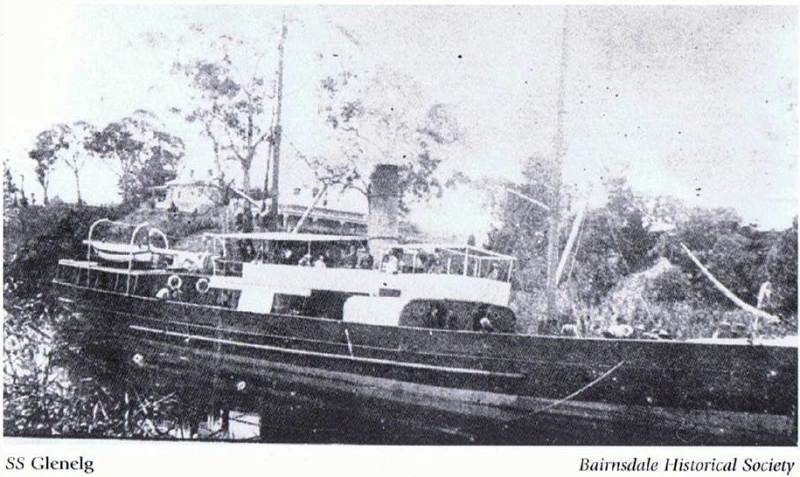
After proceeding to sea for a few miles, keeping the Entrance lights astern, the course was changed to due east when daylight broke, and the curve of the coastline followed. By means of binocles the beach was closely scanned as the vessel proceeded on her way. It was not till nearing Marlo that anything was discovered. At this stage-1 miles from the Entrance and 5 miles from the mouth of the Snowy River-the lifeboat which had weathered the terrific gale on Sunday morning and Sunday night, and in which the three solo survivors had landed, was descried high and dry on the beach, with the oars taken out of her and the life-belts lying near by. Passing Marlo an attempt was made to speak with the lookout, but no answering signal was made and the course was resumed. Ricardo Point (25 miles) was passed, then five miles further along, at Conran Point, the end of the Ninety-Mile Beach was reached. Beware Reef, Pearl Point (off which the Bogong foundered) Sydenhaim Inlet (the outlet of the Bemm River) and Tamboon River, were passed in succession. Cape Everard, 58 miles from the Entrance in a direct line, shortly afterwards loomed up in the distance. It has a peak 538ft high, and the light exhibited from it shown at an elevation of 120ft- is credited with being the most intense on the Victorian coast. The light house itself, built in 1890, is of concrete. Everard is not a signalling station, that is to say, the lighthouse keeper does not take note and report daily the ordinary shipping movements coming within his purview. He answers, however, any signals made to him. The dangers of this cape are two rocks that lie a little distance off the land. One of them is just covered at high water and the other at low water only projects 7ft above the sur face. Their existence was well-known to those navigating the Fenwick, and a most careful watch was kept until they had been located, for a closer course was being steered than usual. Signals were run up by Pilot Molland to have a "speak" with the light house-keeper. It was a long time before that lone man's attention could be secured. Repeated blasts of the whistle were given, the engines were slowed down, the Fenwick danced about merrily on the top of a choppy sea, broadside on, in full view of the lighthouse-keeper's quarters, for nearly half-an-hour before any notice was taken of us. Then, when we had given up hope of being seen, and had got underway again, to our question "Have you any news 1' the answer was run up on the flagstaff " No." As we were about to run up another signal the light-housekeeper showed that, if he had been asleep or slow at first, lie was now very much awake, for he beat us easily by inquiring who we were. He had put us to the trouble of turning back and making a circle to enable him to read our flags, so we did not bother answering his question, but telling him to keep a sharp lookout for wreckage, we proceeded on our way.
It had not been intended, when leaving the Entrance, to travel further eastward than this point, but as by going into every bight on the way along the distance had been greatly lengthened, and as only a slow rate of speed had been maintained, it was thought well to extend the run to Gabo Island, anchor there for the night and return next morning, in preference to turning back and perhaps being unable to got inside the Entrance when we got there. The wind freshened after rounding Cape Everard and was dead against us. Ram Head, Wigan, The Skerries, Sandpatch Point, Little Ram Head and Bastion Point, were the land marks passed till well within sight of Gabo Island. Mallacoota Inlet is 6 miles from Gabo, and Tullaburga Island, where the good ship Monumental City laid her bones and those of her passengers and crew who eore not drowned, lies four miles further along, or within two miles of Gabo. It was exactly half-past 6 p.m. when the Fenwick was brought to a safe and snug anchorage on the western side of the island. Mr Stafford, the head lighthouse keeper, had been watching us through our powerful telescope ploughing his way along for two hours previously, and sent three of his children down to the landing to escort us to his quarters. A boat was lowered and we went ashore and commenced our walk in the gloaming to the lighthouse, leaving the Fenwick in charge of the watch. A tramp of a mile over very broken country-the chief characteristic of which seemed to be the suddenness with which, in the darkness, boulders rose up unexpectedly and struck the unwary pedestrian full in the face …-brought the party to Mr Stafford's quarters.
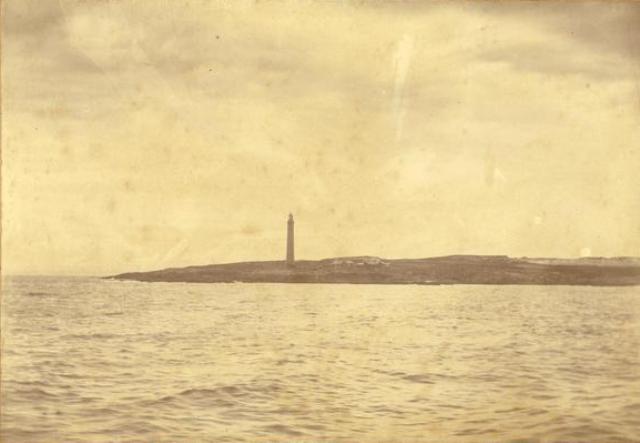 Right: Photograph of Gabo Island, between 1880 and 1899, nla.pic-an21319264 courtesy National Library of Australia.
Right: Photograph of Gabo Island, between 1880 and 1899, nla.pic-an21319264 courtesy National Library of Australia.
A hearty greeting was given the visitors. Mr. Stafford had not heard of the Glenelg disaster, and was grieved when told of the number of lives that had been lost. He concluded we had not given him a call out of idle curiosity and asked could he do anything for us on the wire before communication for the night was cut off. There and then a batch of telegrams was got ready. Eden was rung up by the telephone and informed that about a score of gentle men had unexpectedly landed on the island and invaded the station and required telegrams of the greatest importance relative to a wreck to be put through with all possible despatch. "Ready and all clear" was the answer that came back, and, pressing one of the visitors into the service are clerk while Mr Stafford solicited at the telephone, one by one the messages were got off with surprising rapidity, and eight minutes later they had left Eden on their way to Sydney, from which capital they would be repeated to Melbourne and elsewhere.
Except when small craft may happen to put in for shelter, the lighthouse people hear very little of the outside world oftener than once a quarter. They were greatly pleased to receive the two or three newspapers we had brought them. Mr Stafford was aware of the fact, though, that the Mc'Lean Government was still in power in Victoria, and he expressed the hope that Mr Mc'Lean might long retain of the as Premier, "for," he remarked, " Mr Mc'Lean is a good, honest man, and will do everyone justice." In municipal matters the head light house-keeper was not so well informed. He hadn't heard that Councillor J. B. Rashleigh had got into the president's chair in the Bairnsdale shire-didn't know the man, in fact-but couldn't conceal a hankering desire to see tile man who, with the power of levying rates, and afterwards spending the money thus raised, could have as bad roads in his municipality as the tracks on Gabo Island, where no revenue was collected and no money laid out in that …
The island is 11 miles long by half-a mile broad, tapering at the southern extremity to a narrow point. The lighthouse, as far as the structure itself is concerned, is regarded as the very best and most substantial on any part of the coast. It is built of red granite, of which the island is mostly composed, and the light-a catadrophric…
After varied experiences on the walk back, the Fenwick was reached some time before midnight, and all hands turned in. At 5 o'clock next morning tile first stir was heard on deck, and an hour later, having in the meantime taken on board one of Mr Stafford's daughters, who was taking the opportunity of coming back to civilisation for a while, the anchor was weighed and the Fenwick headed for the Entrance, 'a parting salute being given from the lighthouse and acknowledged by the waving of handkerchiefs. Passing Cape Everard the light house keeper was challenged. He wan not 'napping on this occasion. In several hoists the news was convoyed to him that the s.s. Glenelg had foundered last Sunday and he was asked had he seen missing boat or rafts. He answered No, and in response to " thanks " dipped his colors. After passing Marlo the lifeboat of the Glenelg was taken off the beach by a volunteer crew under the charge by Messrs T. Jemmeson and Alex Cameron, as already described in these columns. Cuninghame was reached at 6.30 and Bairnsdale 4 hours later. The Charlotte Fenwick during the trip well sustained her reputation as an excellent sea boat, and the Messrs Carpenter earned the grateful thanks of all on board for the liberality with which they dispensed hospitality and the pains they went to to minister to everyone's comfort. THE CRUISE OF THE CHARLOTTE FENWICK. (1900, April 3). Bairnsdale Advertiser and Tambo and Omeo Chronicle (Vic. : 1882 - 1918), p. 2 Edition: morning. Retrieved from http://nla.gov.au/nla.news-article84788131
If you think Pittwater has expereinecd some ferry wars, have a perusal of this;
MARINE COLLISION AT BAIRNSDALE. THE CHARLOTTE DAWSON DAMAGED. BAIRNSDALE Friday.
A collision occurred here in the river this morning and resulted in the steamer Charlotte Fenwick being considerably damage. The Charlotte Fenwick and the paddle steamer Tangil were berthed alongside the wharf together at 8 o clock, when the steamer Despatch from Melbourne steamed up the river and crashed between them, causing the Tangil to break away from the moorings, with injuries to the paddle box. The Charlotte Fenwick was crushed against the wharf, until the cables parted, and she then shot into the stream and, narrowly escaping a collision with the Mitchell bridge, cut into the east bank for about 8ft. had the vessel not slewed to starboard as she approached the bridge, a serious disaster must have occurred, as the structure is very unsafe at present. As it was, the starboard davits were carried away and the woodwork smashed, the masthead guys cut and the bow, where the vessel ran into the bunk, damaged. The totsal damage is estimated at 80 pounds. Only two persons were on board at the time. The vessd was recently overhauled and repaired. The captain of the Despatch said that he signalled twice to the engineer to go astern. MARINE COLLISION AT BAIRNSDALE. (1900, April 21). The Argus (Melbourne, Vic. : 1848 - 1957), p. 13. Retrieved from http://nla.gov.au/nla.news-article9057012
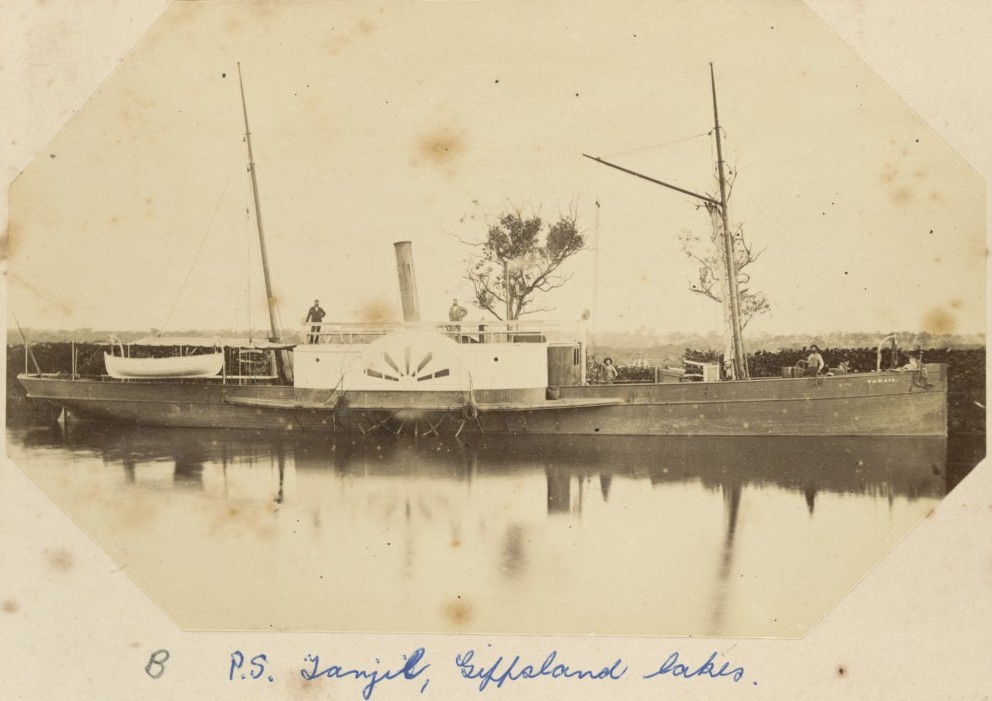
P.S. Tanjil, Gippsland Lakes. [Victoria] circa 1873-1882. Tanjil was generally spelt 'Tangil'. Image No: b22751, courtesy State Library of Victoria.
Charlotte Fenwick, s,-Captain C. E. Young, master and owner of the ketch Mary, recently wrecked at Flinders Island, has been given command of the fishing steamer Charlotte Fenwick, 71 tons, now employed in the Bass Strait fishing industry. Captain Young left Launceston for Melbourne by the Pateena yesterday to take charge of the vessel. COASTAL STEAMERS. (1900, July 18). Examiner (Launceston, Tas. : 1900 - 1954), p. 4 Edition: DAILY. Retrieved June 5, 2013, from http://nla.gov.au/nla.news-article35363729
SHIIPPING. LAKES' Entrance, Wednesday, 9 a.m. Arrived 8 a.m., steamer Charlotte Fenwick, from a fishing cruise. THE CHARLOTTE FENWICK. (1901, January 3). The Sydney Morning Herald (NSW : 1842 - 1954), p. 9. Retrieved from http://nla.gov.au/nla.news-article14363098
THE CHARLOTTE FENWICK. This vessel, formerly a well known excursionist boat, returned to Sydney from the Gippsland Lakes, then just came out of Ward’s Dock after an overhaul. The vessel has been renovated and improved in many respects, with a view to better adapt her for the passenger service. THE CHARLOTTE FENWICK. (1901, January 3). The Sydney Morning Herald (NSW : 1842 - 1954), p. 9. Retrieved from http://nla.gov.au/nla.news-article14363098
Her registered tonnage was increased from 50 tons to 78 and then 87 tons, later on she is registered as 73 tons; more ‘overhauling’.
New Bay Excursion. A very praiseworthy attempt – and one which should be as strongly sup-ported as possible - to open up a traffic to the coastal townships on the eastern shores of the Bay is being made by Mr.M. Walsh, a well known Melbourne gentleman, who has obtained a five months charter of the Charlotte Fenwick to run daily from Melbourne to Mornington, calling en route at Mentone, Mordialloc and Frankston. At these intermediate places expensive jetties have been erected by the Government but for many years they have only been of use to stray yachts or a few small fishing boats so far as seaborne traffic is concerned; and the chief purpose to which they are devoted- and one which was not primarily considered by the Government - is to provide an excellent lovers walk or promenade for seaside visitors. In days gone by the fishing trade was better and before the railway the Frankston jetty was the centre of a large trade in wood, wattle bark, and other traffic, but the advent of the railway, and the proximity to the metropolis, combined with the fact that with a lee shore it is difficult at all times for boats of any size to berth at these piers has been the means of their falling into desuetude, although at times there have been spasmodic attempts made to reorganise something in the shape of communication by water. Everyone is impressed with the desirability of a steamer service to these points, but the difficulty has been to induce any ship-ping company to take up the project, and it is apparent that there is only a possibility for a small boat, economical-ly managed, and capable of doing a goods trade, being run with any degree of profit. The chief attraction of the sinuous Sydney harbour is the numerous points of interest passed on even a short trip, but the usual trip down our Bay is devoid of any interest apart from heaving billows, and an occasional sportive porpoise, until the destination of the steamer is reached. The Charlotte Fenwick service is an attempt to Sydneyize our boat. By keeping close to land the various points along the eastern coast, which are in many parts charmingly picturesque, are brought before the excursionist like a continuous panorama and we venture to say that there are thousands in our metropolis and elsewhere who know nothing of the scenic beauties which are revealed for two or three shillings in a trip in this safe and trim little steamer, the Charlotte Fenwick! Such a bay service should not only be advantageous to dwellers in the metropolis inreaching the townships on the eastern shores of the bay in an agreeable manner, particularly in the summer time,but the residents at the different places and also those living on farms or gar-dens in the country beyond should findin these trips from point to point a new and delightful way of spending an afternoon. The Charlotte Fenwick, which has been chartered for this new service is a safe and comfortable steamer of 87 tons register and she has for some time been engaged in the deep sea fishing business, and her runs have been chiefly between Victoria and Tasmania. Capt. Young, who is in charge, is a well seasoned as well as thoroughly competent officer, and his geniality of manner should make him a favourite with patrons of the steamer. The service proposed is a daily one at a much cheaper rate than that which obtains on other bay boats and it is to be hoped that the effort will receive the encouragement [of all?] A beginning was made on Sunday last, but the patronage accorded before Frankston was reached was only slight chiefly on ac-count of the short notice given of the trip. At the latter place a large number got on board for a shilling return trip to Mornington, and the run was a most enjoyable one indeed. New Bay Excursion. (1902, January 18). Mornington Standard(Vic. : 1889 - 1908), p. 2 Edition: MORNING.. Retrieved from http://nla.gov.au/nla.news-article67081492
THE WEATHER IN THE BAY. Pilots, watermen and old seaside residents regard Thursday's storm as one of the worst samples of weather that has visited the bay for many years. The passenger boats Gem and Charlotte Fenwick plied their routes under considerable difficulty, the waves rolling in on the Port Melbourne shore with a force that made the work of berthing not an altogether easy matter and compelled the exercise of no little skill on the part of the respective skippers to successfully accomplish their half-hourly tasks at their terminus. THE WEATHER IN THE BAY. (1902, March 29). Bairnsdale Advertiser and Tambo and Omeo Chronicle (Vic. : 1882 - 1918), p. 2 Edition: morning.. Retrieved from http://nla.gov.au/nla.news-article86233336
Hired for fishing excursions: The long looked-for schnapper excursion, promoted by Messrs. Dale, Murdoch, and Smith, to Cape Schanck, took place on Saturday and Sunday last. The steamer Charlotte Fenwick left the Yarra at 1.45 p.m. on Saturday with a'genial party of anglers (mostly members), and picked up some members ofthe Werribee Club at Williamstown. She then proceeded direct for her destination, the weather being splendid and the sea very calm. During the run tothe Heads some of the members whiled the time away by having a concert, whilst others were in the arms of Morpheas. A strong south wind sprung up about3.30 a.m. on Sunday, and the captain said he would not go outside, but after a time he changed his mind, and eventually steered for the Schanck. After steaming for about an hour, as the sea did not get any smoother, it was decided to return and try the bay, the water at that time was washing, now and again over the deck aft. On getting in inside fishing began on the Sorrento side and was continued until we arrived at Mornington, but proved a failure, the steamer drifting too fast. We put into the pier at Schnapper Point, and stayed there for about two hours, which was a grent relief for some of the mal-de-mer patients. No more fishing was indulged in, a bee-line being made from the pier for the Yarra.. NOTES. (1902, March 7). North Melbourne Courier and West Melbourne Advertiser (Vic. : 1895 - 1913), p. 3. Retrieved from http://nla.gov.au/nla.news-article103266537
SHIPPING .ARRIVED-February 3. Charlotte Fenwick, s.s., 78 tons, C.E. Young, from Melbourne. Agent-Master, SHIPPING. (1903, February 4). The Mercury (Hobart, Tas. : 1860 - 1954), p. 4. Retrieved from http://nla.gov.au/nla.news-article12269806
TOMORROW. Charlotte Fenwick, to New Norfolk. Thistle, to South Arm, fishing, etc. Seabird, to Brown's River. TO-MORROW. (1903, February 7). The Mercury (Hobart, Tas. : 1860 - 1954), p. 4. Retrieved from http://nla.gov.au/nla.news-article12259983
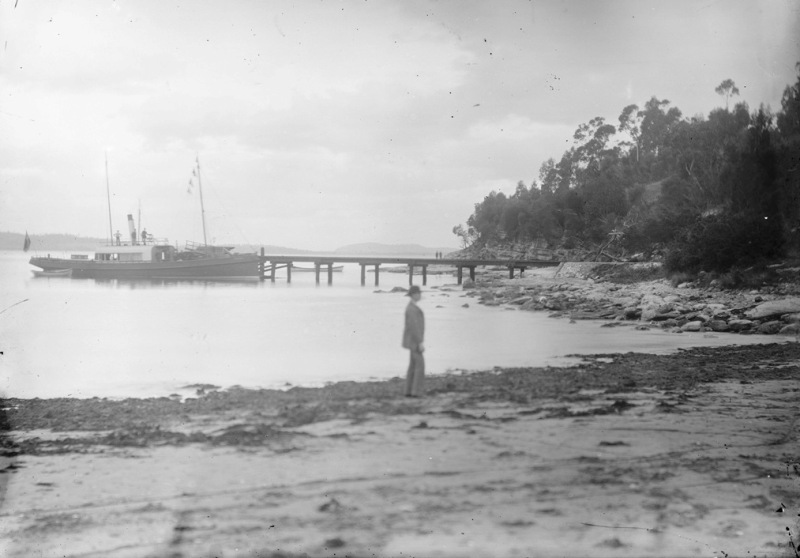
Kingston Beach, Sandy Bay on the Derwent River, Tasmania; showing jetty and ferry steamer, 1900. Image NS1013-1-399, courtesy State Library of Tasmania.
QUEENSCLIFF DAILY, except SATURDAY; SORRENTO and PORTSEA. TUESDAYS and FRIDAYS,-S.S. CHARLOTTE FENWICK leaves Little Dock at 11 a.m. Passenger and cargo. Fares-2/6 single, 4/ week return. Master, agent. The Co-operative Fishermen's Association, Fish Market. Telephone 3080.
TO PICNIC PARTS and others. S S. CHARLOTTE FENWICK. OPEN for CHARTER on SATURDAYs. Master, Agent. The CO OPERATIVE FISHERMEN'S ASSOCIATION, Fish Market. Telephone 3080. Advertising. (1904, February 17). The Argus (Melbourne, Vic. : 1848 - 1957), p. 1. Retrieved from http://nla.gov.au/nla.news-article10598577
The Sorrento Football Club chartered the .s.' Charlotte Fenwick to convey a team across to Quesnscliff on Wednesday last, to play the return match against the R.A.A. Visitors to the number of-70 went across for the trip, and thoroughly enjoyed themselves. ROYAL AUSTRALIAN ARTILLERY V. SORRENTO. (1904, June 18). Mornington Standard (Vic. : 1889 - 1908), p. 5 Edition: MORNING.. Retrieved from http://nla.gov.au/nla.news-article65836601
Another thick fog enveloped the harbour throughout Wednesday night and the early hours of yesterday morning. As the forenoon advanced however, the atmosphere grew bright and clear. A slight mishap befell the steamer Charlotte Fenwick just after entering the river on Wednesday night. In the dense fog she ran aground on the stone wall, but was towed off without difficulty by the tug Alacrity. The Charlotte Fenwick made her usual trip to Queenscliff and Sorrento yesterday. SHIPPING TELEGRAMS. (1904, August 5). The Argus (Melbourne, Vic. : 1848 - 1957), p. 4. Retrieved from http://nla.gov.au/nla.news-article10333399
A meeting in connection with the Dromana Progressive Association was held in the hall on Tuesday night. The following are same of the resolutions carried :-That negotiations be opened up with the captain of the Charlotte Fenwick with a view to establishing better water communication with Melbourne. DROMANA. (1905, September 23). Mornington Standard (Vic. : 1889 - 1908), p. 2 Edition: MORNING.. Retrieved from http://nla.gov.au/nla.news-article65840711
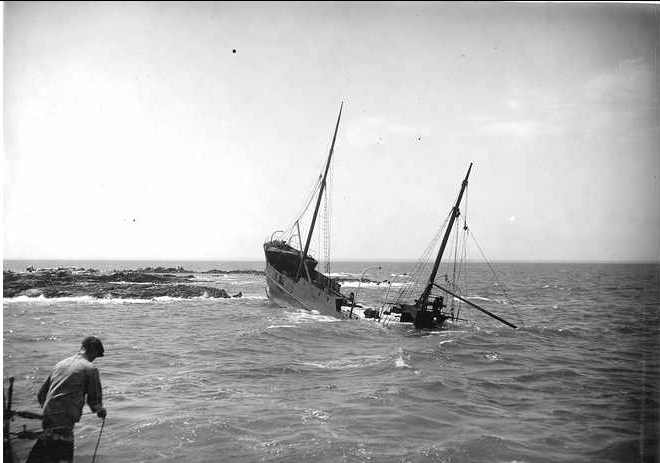 THE AUSTRALIA WRECK. WHY IT SHOULD NOT BE BLOWN UP. The reason which prompted the Defence Department to refrain, for the present, from carrying out its design to blow up the -wrecked steamer Australia, at Melbourne Heads, -were given in a Press interview with Mr. Aikman, M.L.C.:— 'There are twenty men employed on the wreck at the present time, most of whom are working on shares,' remarked Mr. Aikman, 'and these men would be serious losers if they were prevented from getting out the material that remains. It is for this reason that I am opposed to any attempt, being made to blow the vessel up at the present time.' 'The operations are taking a long time, ' suggested the reporter. 'The men employed are trying to get the stuff out as fast as they can,' replied Mr. Aikman, 'but the weather has been against any attempt to tranship the material. There has been the roughest weather down the bay that has been experienced for some years.' Mr. Aikmam mentioned that 100 tons of cast iron and about 50 tons of brass and copper were awaiting transhipment. In fine weather a lifeboat, propelled by a Hercules oil engine, carried the cargo to the Charlotte Fenwick, and this boat took it direct to Melbourne. THE AUSTRALIA WRECK. (1905, October 13). Evening News (Sydney, NSW : 1869 - 1931), p. 3. Retrieved from http://nla.gov.au/nla.news-article113285877 Above right: Wreck of the coastal screw steamer 'Australian' at Wardang Island, near Port Victoria, South Australia which occurred on May 8 1912. Image No. PRG 280/1/16/25, courtesy State Library of South Australia
THE AUSTRALIA WRECK. WHY IT SHOULD NOT BE BLOWN UP. The reason which prompted the Defence Department to refrain, for the present, from carrying out its design to blow up the -wrecked steamer Australia, at Melbourne Heads, -were given in a Press interview with Mr. Aikman, M.L.C.:— 'There are twenty men employed on the wreck at the present time, most of whom are working on shares,' remarked Mr. Aikman, 'and these men would be serious losers if they were prevented from getting out the material that remains. It is for this reason that I am opposed to any attempt, being made to blow the vessel up at the present time.' 'The operations are taking a long time, ' suggested the reporter. 'The men employed are trying to get the stuff out as fast as they can,' replied Mr. Aikman, 'but the weather has been against any attempt to tranship the material. There has been the roughest weather down the bay that has been experienced for some years.' Mr. Aikmam mentioned that 100 tons of cast iron and about 50 tons of brass and copper were awaiting transhipment. In fine weather a lifeboat, propelled by a Hercules oil engine, carried the cargo to the Charlotte Fenwick, and this boat took it direct to Melbourne. THE AUSTRALIA WRECK. (1905, October 13). Evening News (Sydney, NSW : 1869 - 1931), p. 3. Retrieved from http://nla.gov.au/nla.news-article113285877 Above right: Wreck of the coastal screw steamer 'Australian' at Wardang Island, near Port Victoria, South Australia which occurred on May 8 1912. Image No. PRG 280/1/16/25, courtesy State Library of South Australia
STEAMER DISABLED. When proceeding down to Queenscliff yesterday the small steamer Charlotte Fenwick met with an accident to her machinery which rendered her practically helpless. The mishap occurred early in the afternoon several miles on the Melhourne side of the West Channel pile light It was found that the crank shaft is broken and in the circumstances the steamer lay stationary in the locality for some time. The master ultimately determined to try and return to Melbourne under sail and a large tarpaulin was hoisted to serve this purpose. A fair breeze was blowing the the vessel made excellent headway up the harbour, arriving at Williamstown last night. STEAMER DISABLED. (1906, November 15). The Argus (Melbourne, Vic. : 1848 - 1957), p. 8. Retrieved from http://nla.gov.au/nla.news-article9672177
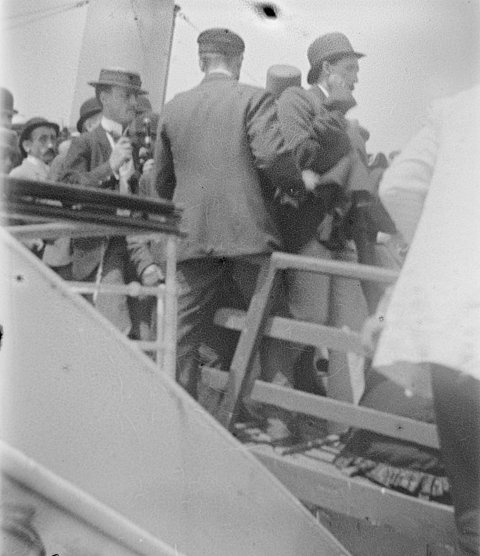 SORRENTO We have been having some very beautiful days, which suggested the early summer, but on Tuesday morning there was a great change, the sky was overcast, and angry billows dashed against the sea wall, throwing spray right over the road, wetting the passer by, at the Mornington Hotel, and Miss Isherwood's corner. Several young ladies assembled on the pier, to go to Melbourne by the "Charlotte Fenwick." A telegram was received that she could come no farther than Portsea, so they had to return to their homes, Mr. Morgan, the agent, storing their luggage. Great damage is being done to the foreshore, and it is feared if something is not speedily done, the road will be washed away in front of the Mornington Hotel, which will be a great inconvenience. We are told that Mr. Bartells is coming to have it repaired, but we have had so many promises, that we hardly know whether to believe it or not. SORRENTO. (1907, August 10). Mornington Standard (Vic. : 1889 - 1908), p. 2 Edition: MORNING.. Retrieved from http://nla.gov.au/nla.news-article65829120
SORRENTO We have been having some very beautiful days, which suggested the early summer, but on Tuesday morning there was a great change, the sky was overcast, and angry billows dashed against the sea wall, throwing spray right over the road, wetting the passer by, at the Mornington Hotel, and Miss Isherwood's corner. Several young ladies assembled on the pier, to go to Melbourne by the "Charlotte Fenwick." A telegram was received that she could come no farther than Portsea, so they had to return to their homes, Mr. Morgan, the agent, storing their luggage. Great damage is being done to the foreshore, and it is feared if something is not speedily done, the road will be washed away in front of the Mornington Hotel, which will be a great inconvenience. We are told that Mr. Bartells is coming to have it repaired, but we have had so many promises, that we hardly know whether to believe it or not. SORRENTO. (1907, August 10). Mornington Standard (Vic. : 1889 - 1908), p. 2 Edition: MORNING.. Retrieved from http://nla.gov.au/nla.news-article65829120
Left: Disembarking from bay steamer, possibly at Sorrento, ca. 1890-ca. 1910, Image No. H83.94/327, courtesy State Library of Victoria.
Great satisfaction is felt that the coal strike is over, and the Hygeia and Charlotte Fenwick are able to make their usual running. SORRENTO. (1907, November 30). Mornington Standard (Vic. : 1889 - 1908), p. 2 Edition: MORNING.. Retrieved from http://nla.gov.au/nla.news-article65829561
SORRENTO, PORTSEA, QUEENSCLIFF.-S.S. CHARLOTTE FENWICK Leaves foot Spencer street wharf 10 a.m. daily. Easiest way to forward luggage and cargo. ST. LEONARDS when required. Master, agent. Tel.3080.NEW YEAR'S DAY EXCURSION.-QUEENSCLIFF and ST. LEONARDS. - S.S. CHARLOTTE FENWICK will leave berth, foot Spencer street, 10 a.m. New Year's Day (weather permitting), leaving Queenscliff 1 p.m., St. Leonard’s .1.40 p.m. on return. Fare Day Return, 2/1, hot water on board. Master, Agent. Telephone 3080. Advertising. (1908, January 1). The Argus (Melbourne, Vic. : 1848 - 1957), p. 1. Retrieved from http://nla.gov.au/nla.news-article10655119
BAY STEAMER DAMAGED. LOSES HER MAST. QUEENSCLIFF, Wednesday -The steamer Charlotte Fenwick, which trades between Melbourne and Bay ports, presented a rather peculiar appearance this afternoon, upon arriving at Queenscliff, through having lost her mast during the voyage down. Upon inquiry from Captain Chapman it was ascertained that whilst a donkey engine and boiler, estimated to weigh 2 tons, was being unloaded at St Leonards the forward chain plate on the port side broke when the slings were over the pier, through the vessel rolling on the surge, and the reversing gear of the steamer becoming clogged, the mast broke off at the deck, but no person was injured. The master of the vessel, before slinging the boiler, rigged n protective chain, but this, apparently, was without avail. The non appearance here of the steamer occasioned considerable concern amongst the local fishermen some of whom, being late home required baskets for their morning's catch of barracouta. However, the Charlotte Fenwick sailed for Melbourne with over 200 baskets aboard. BAY STEAMER DAMAGED. (1908, June 18). The Argus (Melbourne, Vic. : 1848 - 1957), p. 4. Retrieved from http://nla.gov.au/nla.news-article10665115
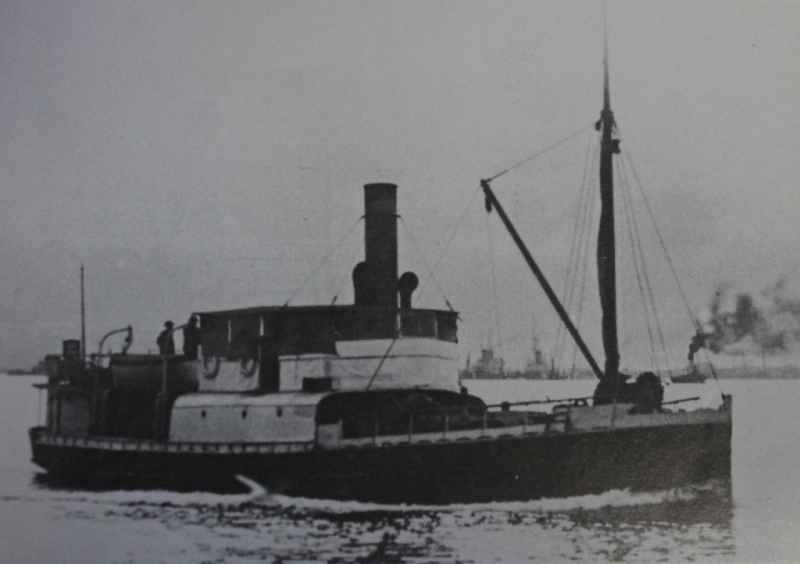
Charlotte Fenwick when in Victoria circa 1915. Courtesy Buster Browne Collection.
Mr. I. Prendergast, the club officer, members and their friends were able to see every stage of the race in comfort. The s.s. Manawatu and the s.s. Charlotte Fenwick, the St. Kilda Yacht Club's launch Alfreda, and the Dorothy were all crowded, while the small craft, both motor and sailing boats that were cruising about, were too numerous to be counted. SAYONARA CUP. THE SECOND RACE. (1909, February 8). The Argus (Melbourne, Vic. : 1848 - 1957), p. 7. Retrieved from http://nla.gov.au/nla.news-article10687299
At a meeting of the Marine Board on Friday reports were read concerning the running down of a small 17-foot sailing boat by the s.s. Charlotte Fenwick on the evening of April 12, off Williamstown. The evidence showed that, the sailing boat, which was being rowed at the time, was not carrying the white light required by the regulations, and that the steamers lights were all burning brightly. It was impossible, in the circumstances, for the man at the wheel of the steamer to have seen the boat until she was right under her bows. The two occupants of the boat, which was sunk, were promptly rescued and landed at the Ann-street pier. It appeared also that the sailing boat had some little time before this mishap narrowly missed being run down by another steamer-. The reports were received. GENERAL NEWS. (1909, April 19). The Argus (Melbourne, Vic. : 1848 - 1957), p. 8. Retrieved from http://nla.gov.au/nla.news-article10691456
NEW YEAR'S DAY. ST. LEONARD'S and QUEENSCLIFF. 2/1 Return. S.S. CHARLOTTE FENWICK Leaves Little Dock (foot of Spencer-street) 10 a/m/. for St. Leonard's and Queenscliff, leaving St. Leonard’s at 5 p.m. on return journey. Hot water provided. FJCARPE.NTER. Phone 1330, City. S.S. CHARLOTTE FENWICK, From Little Dock, 10 a.m. daily, to Sorrento, Portsea, and Queenscliff. Fares-Single, 2/0; week return, 4/ Agent. F. Carpenter. Advertising. (1909, December 31). The Argus (Melbourne, Vic. : 1848 - 1957), p. 1. Retrieved from http://nla.gov.au/nla.news-article10757299
STEAMER IN TROUBLE. Melbourne, January 14. The coastal steamer Charlotte Fenwick was proceeding towards the west channel pile light on the homeward journey tonight when she slewed round and steamed slowly towards Queenscliff. It is surmised that the engines have broken down or some other accident has occurred. A rising east north-east gale is mowing. The steamer, which displays no signal is quite safe. SHIPPING ACCIDENTS. (1910, January 15). The Advertiser (Adelaide, SA : 1889 - 1931), p. 9. Retrieved from http://nla.gov.au/nla.news-article5222524
STEAMER CHARLOTTE FENWICK, APPARENTLY DISABLED. A message received from Queenscliff states that the well known bay steamer Charlotte Fenwick, was anchored at 6 o'clock last evening near No 8 buoy, in the west channel She is apparently disabled but in no danger although a moderate easterly gale was blowing The Charlotte Fenwick trades between Melbourne, Sorrento Portsea, and Queenscliff, making daily trips. At 8 o’clock last night the Charlotte Fenwick was still anchored. STEAMER CHARLOTTE FENWICK. (1910, January 15). The Argus (Melbourne, Vic. : 1848 - 1957), p. 18. Retrieved from http://nla.gov.au/nla.news-article10827801
THE "CHARLOTTE FENWICK." Nothing is so invigorating as a trip down the bay, and before the winter sets in everyone should avail themselves of the present fine weather, and, with hamper in hand, board the good little steamship, "Charlotte Fenwick." On Eight Hours' Day, with some friends, we visited Sorento, Portsea and Queenscliff, and enjoyed our trip greatly, but had the experience of all those on pleasure bent on that occasion, of strong winds and a rough sea. But no one feared danger, and there was a large number of passengers, as the "Charlotte Fenwick" is well known for her sea-going qualities and her steadiness, so that few suffer from sea sickness. Also the knowledge that she is in the hands of an experienced and trustworthy seaman, Captain J. Chapman is a man of lengthened experience of the Australian coast, and for the nervous this assurance is valuable. THE "CHARLOTTE FENWICK.". (1910, May 6). Fitzroy City Press (Vic. : 1881 - 1920), p. 4. Retrieved from http://nla.gov.au/nla.news-article65684833
 Left: THE "CHARLOTTE FENWICK.". (1912, January 12). Fitzroy City Press (Vic. : 1881 - 1920), p. 3. Retrieved from http://nla.gov.au/nla.news-article65686654
Left: THE "CHARLOTTE FENWICK.". (1912, January 12). Fitzroy City Press (Vic. : 1881 - 1920), p. 3. Retrieved from http://nla.gov.au/nla.news-article65686654
MISHAP TO CHARLOTTE FENWICK. SORRENTO, Wednesday) - The s.s. Charlotte Fenwick has met with an accident to her machinery, and is lying it anchor waiting for a tug. MISHAP TO CHARLOTTE FENWICK. (1912, July 11). The Argus (Melbourne, Vic. : 1848 - 1957), p. 14. Retrieved from http://nla.gov.au/nla.news-article10506963
THE CHARLOTTE FENWICK COLLISION. The Melbourne Marine Board, at its meeting on Friday, dealt with the report from the inspector of shipping upon the recent collision which took place between the Charlotte Fenwick and a boat belonging to the Kalomo. The report stated that the Charlotte Fenwick endeavoured to pass between the boat (which was in charge of the Kalomo's carpenter) and the wharf. For some reason the boat's head was turned back towards the Kalomo, thereby crossing the track of the Charlotte Fenwick, whose muster sounded his whistle and stopped his engines. He tried to pass around the stern of the boat, shouting to the boats crew to keep pulling. In spite of warning, they made no attempt to get out of the way of the steamer. The result was that the Charlotte Fenwick crashed into the boat, throwing the carpenter and a lascar into the water. The carpenter was rescued, but the body of the lascar was not recovered. The report, which was considered in committee, was sent on to the Court of Marine Inquiry for formal investigation. No charge was made. CHARLOTTE FENWICK COLLISION. (1912, September 23). The Sydney Morning Herald (NSW : 1842 - 1954), p. 10. Retrieved from http://nla.gov.au/nla.news-article15363009
Lascar; A lascar was a sailor or militiamanfrom the Indian Subcontinent or other countries east of the Cape of Good Hope, employed on European ships from the 16th century until the beginning of the 20th century. The word comes from the Persian Lashkar, meaning military camp or army, and al-askar, the Arabic word for a guard or soldier. The Portuguese adapted this term to lascarim, meaning an Asian militiaman or seaman, especially those from the Indian Subcontinent. Lascars served on British ships under 'lascar' agreements. These agreements allowed shipowners more control than was the case in ordinary articles of agreement. The sailors could be transferred from one ship to another and retained in service for up to three years at one time. Lascar. (2013, May 13). In Wikipedia, The Free Encyclopedia. From http://en.wikipedia.org/w/index.php?title=Lascar&oldid=554878494
PORT OF GEELONG – ARRIVED Sept. 14. Charlotte Fenwick, s.s. from Melbourne. PORT OF GEELONG. (1914, September 21). The Argus (Melbourne, Vic. : 1848 - 1957), p. 11. Retrieved from http://nla.gov.au/nla.news-article10807470
The following was the catch of fish on Friday of last week by the Queenscliff fishermen toward the Mayor's Patriotic Fund:-Sent to the Melbourne market, per s.s. Charlotte Fenwick:-74 baskets of 'couta, 14 baskets schnapper, 1 1/2 doz. crayfish. Sold to Mr R. Tobias-13 baskets couta, 7 baskets schnapper, 1 basket flathead. The full returns are not yet to hand, but it is expected sales will approach £50. Fishermen's Catch. (1914, December 5). Queenscliff Sentinel, Drysdale, Portarlington, Sorrento Advertiser (Vic. : 1914 - 1918), p. 2. Retrieved from http://nla.gov.au/nla.news-article92104643
S. S CHARLOTTE FENWICK- . 73 Tons. Time Table. Leaves Little Dock (foot of Spencer st., Melbourne, weather and other circumstances permitting, at 9.30 a.m. daily; with Passengers and Cargo (Saturdays and Sundays excepted, unless specially arranged) as under: Mondays, Thursdays and Fridays Sorrento direct; thence Portsea and Queenscliff. –Tuesdays;-St. Leonards direct; then to Queenscliff, Portsea and Sorrento, returning to Queensclif. Wednesdays-Dromana direct; thence Rye, and Sorrento (passengers only) and Queenscliff. FARES-Dromana, single, 3s. Other Ports, single, 2 6d.; Electrie Light throughout and all mod - conveniences. Hot Meals, 1s. Arriving in Melbourne about-8 o'clock Each Evening; Advertising. (1915, January 23). Queenscliff Sentinel, Drysdale, Portarlington, Sorrento Advertiser (Vic. : 1914 - 1918), p. 1. Retrieved from http://nla.gov.au/nla.news-article92106185
NEW BAY STEAMER. Considerable interest has been taken in Queenscliff and Sorrento in the new Bay steamer, as mentioned last week, the boat is at hand, and will shortly commence her regular running. The Argus, in referring to the new boat, says:- 'Through the enterprise of a number of business people residing in Queenscliff and Sorrento, a steamer, named Awaroa, which arrived here from Zealand some weeks ago, is at present receiving a: searching overhaul, and being generally renovated for her new venture, no reasonable expense being spared in bringing her to the highest possible state of efficiency. Capable of accommodating 500 passengers, as well as a considerable quantity of cargo, the Awaroa will run through out the whole year, and will, it is expected, give a stimulus to the restricted passenger traffic of the winter months: Of 344 tons gross, the Awaroa was built of wood in Sydney 10 years ago, but has since been trading in New Zealand waters. Her passenger accommodation, equal to 500 persons, is, very comfortable, electric light and other conveniences being installed. Should sufficient inducement offer, the vessel will include Dromana in her itinery. Capt McNair, from the Charlotte Fenwick, will have charge of the Awaroa; and Mr Watt, also from the former steamer; is to be chief engineer. It is stated that the Queenscliff and Sorrento Steamship Company, under whose auspices the Awaroa will trade, is composed almost exclusively of local business. people.' NEW BAY STEAMER. (1915, February 27). Queenscliff Sentinel, Drysdale, Portarlington, Sorrento Advertiser (Vic. : 1914 - 1918), p. 2. Retrieved from http://nla.gov.au/nla.news-article92104841
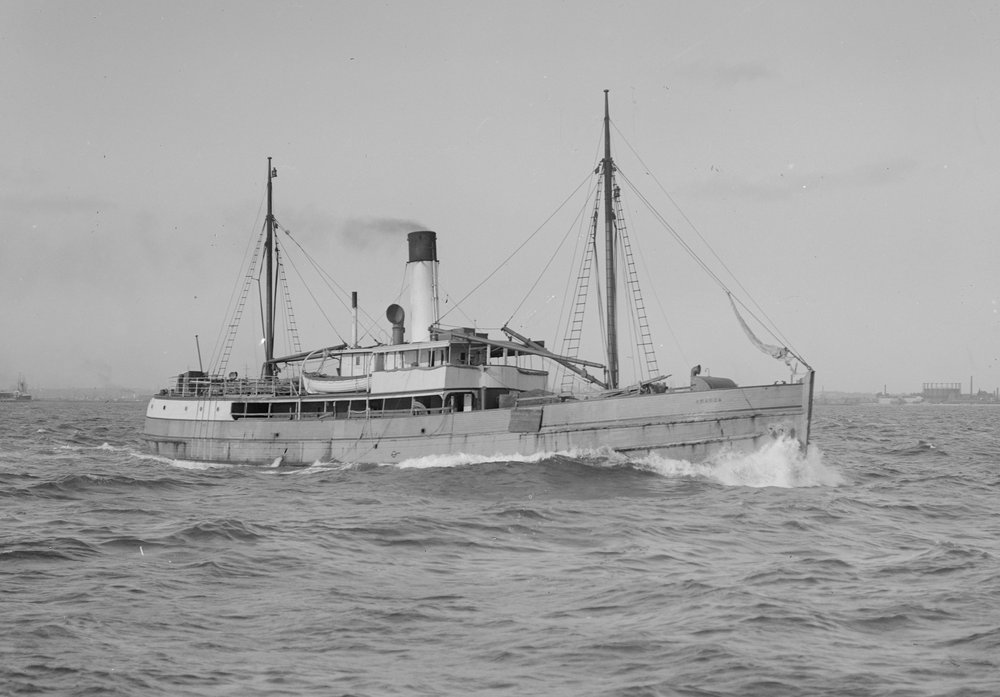
Awaroa on Gippsland Lakes. Image no 174383, courtesy State Library of Victoria.
BELGIAN FUND. Queenscliff's Efforts. Water Carnival. The following donations were received in connection with the recent Water Sports: Mr Carpenter (s.s. .Charlotte Fenwick) ... £ 1 1 0. BELGIAN FUND. (1915, April 24). Queenscliff Sentinel, Drysdale, Portarlington, Sorrento Advertiser (Vic. : 1914 - 1918), p. 2. Retrieved from http://nla.gov.au/nla.news-article92105578
If rumors current are true, it is not unlikely that Queenscliff and Sorrento will be well equipped as far as Bay boats are concerned. The Awaroa, which met with untimely trouble, is expected to very soon take up her running, and is stated to be even better, fitted up and more adaptable than before her accident. Then it is also rumored that the Charlotte Fenwick, which has now been running with consistency for some time, is to be displaced by a much larger and more up-to date boat. We give the rumors for what they may be worth. They may be correct, but in due time we expect the announcements will be made through these columns. RE-OPENING OF ST. GEORGE'S CHURCH. (1915, November 6). Queenscliff Sentinel, Drysdale, Portarlington, Sorrento Advertiser (Vic. : 1914 - 1918), p. 2. Retrieved from http://nla.gov.au/nla.news-article92105426
The most interesting development on Thursday was the sailing of the Bay steamer Charlotte Fenwick with firewood in place of coal. Her owner, Mr. F. Carpenter, said he was able to run the steamer with wood fuel, and in view of the withdrawal of the Awaroa, of the Sorrento and Queens cliff Steamship Co. Ltd., the Charlotte Fenwick would make a special trip next Saturday. This steamer, which is a wooden craft of 76 tons, was built at Sydney in 1883, and for several years has been a familiar trader between Little Dock and Bayside ports. While the railway department has already contemplated the use of firewood, in certain instances, the idea of wood as fuel is not generally associated with steamers, and the performance of the Charlotte Fenwick occasioned some comment in shipping circles. When the matter was brought under the notice of a represent:tive of "Lloyd's Register," he said-"I have known a case where a 1000-ton steamer was driven by firewood, but the difficulty is the large quantity that is required. Compared with a given quantity of coal, you would require four times the amount of wood to produce the same result. On an ordinary steamner," he continued, "one would not have enough space to store the wood required, and in addition it would be difficult to handle." THE SHIPPING TRADE. (1916, November 11). Leader (Melbourne, Vic. : 1914 - 1918), p. 23 Edition: WEEKLY. Retrieved from http://nla.gov.au/nla.news-article89767646
Advertisments continued until the end of February 1917 for her runs then cease. By October of that same year she is advertised for sale;
S.S CHARLOTTE FENWICK" Leaves Little Dock, 8.30 a.m., as under:-Tuesday and Fridays-Dromana, Rye, Sorrento, Portsea, Queenscliff.- Wednesday-Rye, Sorrento, Portsea, Queenscliff, and St Leonards. Fare, 1/. F. CARPENTER. 'Phone 0330._ SPECIAL NOTICE. The S.S. RELIANCE Will NOT SAIL Until Further Notice. F. .CARPENTER. Phone… Classified Advertising. (1917, February 20). The Argus (Melbourne, Vic. : 1848 - 1957), p. 1. Retrieved from http://nla.gov.au/nla.news-article1598349
October 1917 advertised for sale:
FOR IMMEDIATE DELIVERY. STEAMER CHARLOTTE FENWICK. Suitable towing or cargo. Excellent order. New Certificate. COWPER and SON, Agents, MELBOURNE. Advertising. (1917, October 16). The Sydney Morning Herald (NSW : 1842 - 1954), p. 1. Retrieved from http://nla.gov.au/nla.news-article15749188
In January 1918 she’s advertised for sale in Brisbane:
"CHARLOTTE FENWICK." This small, Serviceable Steamer for Sale. Built best selected timbers. Draught loaded, 6ft. 9in., 90 x 18 x 7 6. C.S C. cylinders 12 and 24 and 18 stroke. Hold, winch, electric light, saloon, speed 9 knots. Also a number of small vessels and motor launches. A. J. POWELL, 377 Queen-street, Brisbane. Advertising. (1918, February 2). The Brisbane Courier (Qld. : 1864 - 1933), p. 2. Retrieved from http://nla.gov.au/nla.news-article20209633
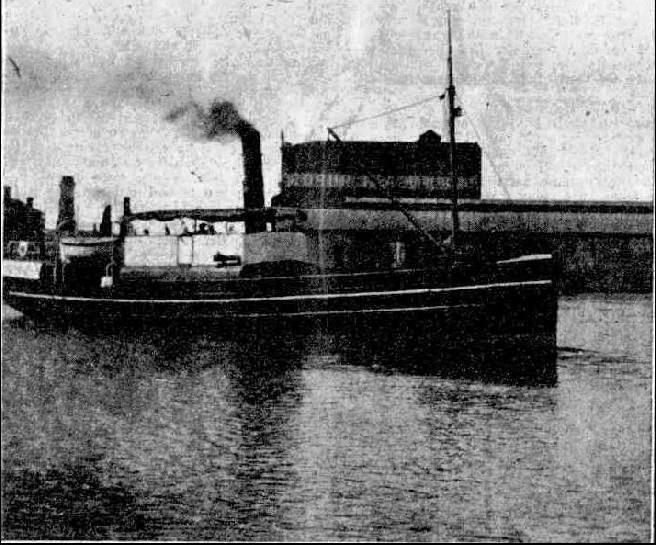 Mr E. Dunn, licensee of Cochrane's Hotel, Day-street Sydney, is interested in the cargo boat, 'Charlotte Fenwick,' a photo of which appears on our front page. Mr. Dunn has just returned from Melbourne, and informed us on the phone On Wednesday that the boat had been delayed in Melbourne owing to the engineer's strike. She was to arrive in Sydney this week, in charge of Captain Archie Jurd, and will take up the running on the Hawkesbury River at once. The ''Charlotte- Fenwick’ has' been thoroughly overhauled, and is in first-class order. DEBATING SOCIETY. (1918, September 27). Windsor and Richmond Gazette (NSW : 1888 - 1954), p. 10. Retrieved from http://nla.gov.au/nla.news-article86150940
Mr E. Dunn, licensee of Cochrane's Hotel, Day-street Sydney, is interested in the cargo boat, 'Charlotte Fenwick,' a photo of which appears on our front page. Mr. Dunn has just returned from Melbourne, and informed us on the phone On Wednesday that the boat had been delayed in Melbourne owing to the engineer's strike. She was to arrive in Sydney this week, in charge of Captain Archie Jurd, and will take up the running on the Hawkesbury River at once. The ''Charlotte- Fenwick’ has' been thoroughly overhauled, and is in first-class order. DEBATING SOCIETY. (1918, September 27). Windsor and Richmond Gazette (NSW : 1888 - 1954), p. 10. Retrieved from http://nla.gov.au/nla.news-article86150940
ILLUSTRATED PHOTO; The ' CHARLOTTE FENWICK is the cargo boat that will commence running on the Hawkesbury River on 1st October. Captain Archie Jurd will be in command with Mr. A. McKay as engineer. The 'Charlotte Fenwick is fitted with a powerful electric installation, and will be able to load at any hour of the night. She will convey fruit from the Hawkesbury River to Sydney on Tuesdays and Saturdays, and will also run on Thursdays during the busy season if required. She will land her cargo at the Macleay Company's Wharf, within a stone's throw of the Fruit Markets WINDSOR MUNICIPAL COUNCIL. (1918, September 27).Windsor and Richmond Gazette (NSW : 1888 - 1954), p. 1. Retrieved from http://nla.gov.au/nla.news-article86150956
Whilst on her way to Sydney last week the Charlotte Fenwick was obliged to call at the Lakes Entrance, owing to her boiler tube bursting. No Title. (1918, October 8). Gippsland Mercury (Sale, Vic. : 1914 - 1918), p. 3. Retrieved from http://nla.gov.au/nla.news-article89100499
The steamer Charlotte Fenwick, which for a considerable time past has been engaged in the Hobson's Bay trade, arrived in Sydney yesterday. STEAMERS DUE TO-DAY. (1918, October 8). The Sydney Morning Herald (NSW : 1842 - 1954), p. 8. Retrieved from http://nla.gov.au/nla.news-article15805610
The Charlotte Fenwick, s, is 73 tons when she arrives. The next week she begins her runs;
HAWKESBUBY RIVER and PITTWATER (and ports).Cargo received daily. S.S. CHARLOTTE FENWICK, Macleay River Wharf, Barker-street, foot Bathurst, Sailing MONDAY, 9 a.m.; THURSDAY, 6p.m.Telephone. City 1618. Advertising. (1918, October 23). The Sydney Morning Herald (NSW : 1842 - 1954), p. 1. Retrieved from http://nla.gov.au/nla.news-article15807768
HAWKESBURY RIVER, PITTWATER, NEWPORT, PALM BEACH,. and MANGROVE.-S.S. CHARLOTTE FENWICK leaves Macleay River Wharf, off foot of Bathurst-st, every MONDAY, 10 a.m., and THURSDAY, 5 p.m. Cargo received daily. Telephone, City 1618. Advertising. (1918, December 3). The Sydney Morning Herald (NSW : 1842 - 1954), p. 1. Retrieved from http://nla.gov.au/nla.news-article15813662
PROJECTED DEPARTURES.Erina, s, for Gosford and Woy Woy; Gosford, s, for Gosford, Woy Woy, and Wyong; Charlotte Fenwick, s, for Hawkesbury River, Bay View, Palm Beach, Pittwater, Newport, etc.; PROJECTED DEPARTURES.—Jan. 1. (1920, January 1). The Sydney Morning Herald (NSW : 1842 - 1954), p. 7. Retrieved from http://nla.gov.au/nla.news-article15880722
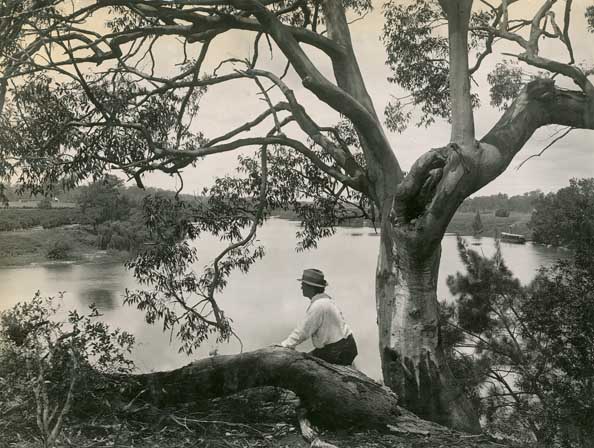 DESTROYED BY FIRE. FATE OF THE CHARLOTTE FENWICK. An outbreak of fire on the steamer Charlotte Fenwick, on the Hawkesbury River, resulted in the vessel being gutted and sunk. The Charlotte Fenwick left Sydney with a full general cargo for the Hawkesbury River. She had landed all her cargo, and arrived at Page's Wharf, Portland Head, at 6 o'clock on Friday evening at 7 o’clock all hands retired with the exception of a fireman, who extinguished the fires in the stokehold, and after putting on the dampers retired to his bunk. Shortly after 10.30 the crew were awakened with suffocating volumes of smoke issuing from the stokehold. With difficulty a portion of the crew managed to jump ashore, while Captain Kennedy, the master of the vessel, was assisted off in a semi-conscious state. The remainder of the crew were rescued by a local boat. The crew made an effort to extinguish the flames with the pumps, but were driven back. The fire raged until 6o'clock on Saturday morning, and after being burnt to the water's edge the vessel sank. She now lies at right angles to the wharf with the funnel slightly showing at low water. The Charlotte Fenwick was a vessel of 73 tons. She was built at Sydney in 1883, and owned by Mr. A. J. Elleker, Captain A. Jurd, Mr. A. Mackay, and Mr. B. J. Thomas. She was insured in the United Insurance Company. Mr. A. J. Elleker, part owner of the vessel, stated yesterday that negotiations were proceeding for the purchase of another steamer to replace the lost vessel. DESTROYED BY FIRE. (1920, May 14). Windsor and Richmond Gazette (NSW : 1888 - 1954), p. 7. Retrieved from http://nla.gov.au/nla.news-article85875940
DESTROYED BY FIRE. FATE OF THE CHARLOTTE FENWICK. An outbreak of fire on the steamer Charlotte Fenwick, on the Hawkesbury River, resulted in the vessel being gutted and sunk. The Charlotte Fenwick left Sydney with a full general cargo for the Hawkesbury River. She had landed all her cargo, and arrived at Page's Wharf, Portland Head, at 6 o'clock on Friday evening at 7 o’clock all hands retired with the exception of a fireman, who extinguished the fires in the stokehold, and after putting on the dampers retired to his bunk. Shortly after 10.30 the crew were awakened with suffocating volumes of smoke issuing from the stokehold. With difficulty a portion of the crew managed to jump ashore, while Captain Kennedy, the master of the vessel, was assisted off in a semi-conscious state. The remainder of the crew were rescued by a local boat. The crew made an effort to extinguish the flames with the pumps, but were driven back. The fire raged until 6o'clock on Saturday morning, and after being burnt to the water's edge the vessel sank. She now lies at right angles to the wharf with the funnel slightly showing at low water. The Charlotte Fenwick was a vessel of 73 tons. She was built at Sydney in 1883, and owned by Mr. A. J. Elleker, Captain A. Jurd, Mr. A. Mackay, and Mr. B. J. Thomas. She was insured in the United Insurance Company. Mr. A. J. Elleker, part owner of the vessel, stated yesterday that negotiations were proceeding for the purchase of another steamer to replace the lost vessel. DESTROYED BY FIRE. (1920, May 14). Windsor and Richmond Gazette (NSW : 1888 - 1954), p. 7. Retrieved from http://nla.gov.au/nla.news-article85875940
Above Left: View of Hawkesbury River from Ebenezer (NSW), created 2/1918, Government Printing Office 1 - 18646, courtesy State Library of NSW.
The Charlotte Fenwick was only 37 years old when destroyed. Portland head is now known as Ebenezar and near Sackville on the Hawkesbury River. It has the distinction of having Australia’s oldest church which still conducts services every Sunday. This early pioneer church was built in 1809 (some sources state construction was begin by early settlers in 1906) as a result of the contributions of a group of families living at Portland Head in the Hawkesbury.
The ferry that replaced the Charlotte Fenwick on her run makes you wonder if this 'syndicate' were very unlucky or ...
The s.s. Erringhi is now being .run by !the 'Charlotte Fenwick' syndicate, with Captain Archie Jurd in command. The 'remains' of the 'Charlotte Fenwick' were towed to Brooklyn last week. Week to Week. (1920, June 11). Windsor and Richmond Gazette (NSW : 1888 - 1954), p. 4. Retrieved from http://nla.gov.au/nla.news-article85878505
STEAMER ERRINGHI STRIKES BARRANJOEY ROCKS. On one of her usual trips from the Hawkesbury River to Sydney the coasting steamer Erringhi struck Warner's Rock, near Barranjoey during the early hours of yesterday morning. Later in the day another river steamer, the Kallawatta, succeeded in dragging the Erringhi off, and towing her to the Jetty at Palm Beach. Captain Jurd, the master of the Erringhi, stated that hazy conditions prevailed when the Erringhi commenced her voyage This probably accounted for the vessel losing her course and striking the rock. The Barrenjoey lighthouse-keeper discovered the plight of the Erringhi, but in answer to a question Captain Jurd reported that the crew were in no immediate danger. The sea was calm Between 9 and 10 o'clock the Kallawatta arrived. Some ot the Erringhi's cargo was jettisoned, and shortly before 8 o'clock she was towed off into deep water, and afterwards to Palm Beach. An examination revealed the fact that the damage was not extensive. The timbers of the vessel had been strained by contact with the rocks sufficient to cause a leakage. At low tide this morning an attempt will be made to effect temporary repairs, and it is hoped that the vessel will resume her voyage at 7 o'clock or shortly afterwards.
The Erringhi is a wooden vessel of 96 tons, built In 1907 at Clarence Town. Her principal dimensions are - Length, 101ft,' breadth, 21ft, and depth 7.5ft. She is owned by a syndicate, who suffered the loss of the coaster Charlotte Fenwick by fire a few weeks ago and replaced that steamer by the Erringhi. The vessel is insured with the United Insurance Company for £3589. STEAMER ERRINGHI. (1920, June 12). The Sydney Morning Herald (NSW : 1842 - 1954), p. 13. Retrieved from http://nla.gov.au/nla.news-article15893744
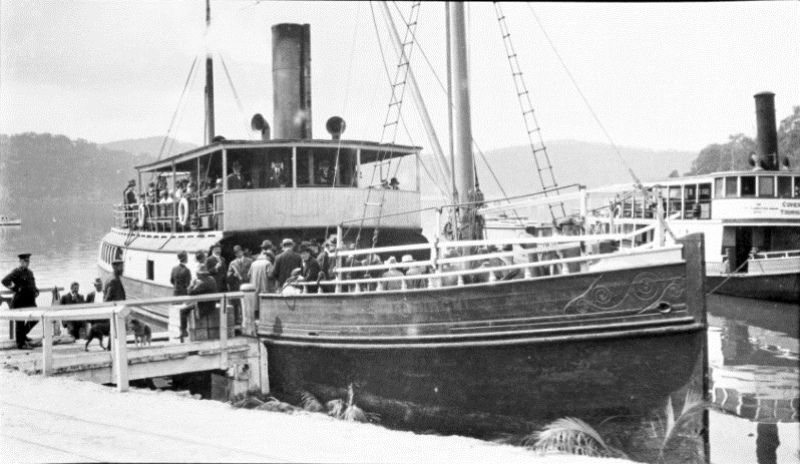
This image depicts the Hawkesbury Steam Navigation Company's ferry SS ERRINGHI at Brooklyn on the Hawkesbury River. ERRINGHI was purchased by the company in 1912, by the syndicate Captain Jurd was part of in June 1920 and traded on the Hawkesbury River up to the late 1940s. The vessel was scuttled off Sydney Heads in 1951. Image no 20579 courtesy Australian National Maritime Museum and by Samuel Hood.

View showing jetty and cottage used as a customs house at Broken Bay with Charlotte Fenwick (?)circa 191 in background, Image No. 4481_a026_000766 from State Records of NSW's Flickr.
.jpg?timestamp=1370647911922) CHARLOTTE FENWICK from Allan C. Green collection of glass negatives, image No. 49212534, ourtesy State Library of Victoria.
CHARLOTTE FENWICK from Allan C. Green collection of glass negatives, image No. 49212534, ourtesy State Library of Victoria.

Berry's bay, circa 1879, from the Tyrell Collection on Flickr, courtesy the Powerhouse Museum.
Charlotte Fenwick threads collected by A J Guesdon, 2013.